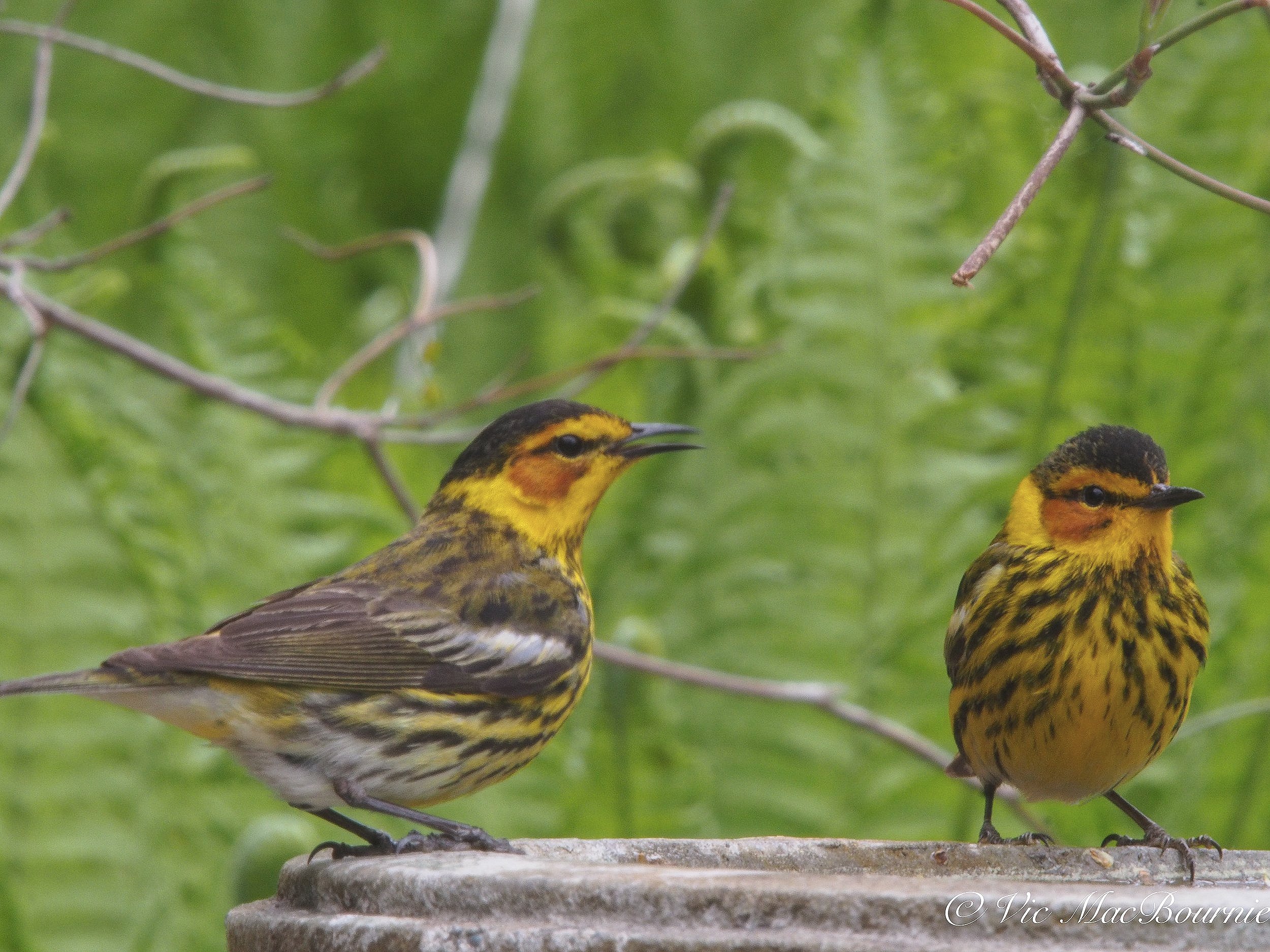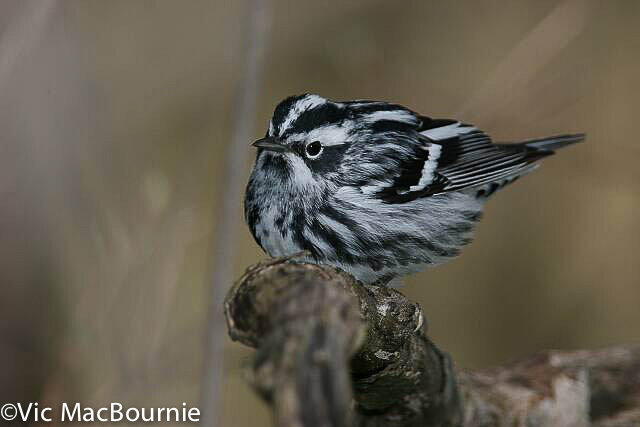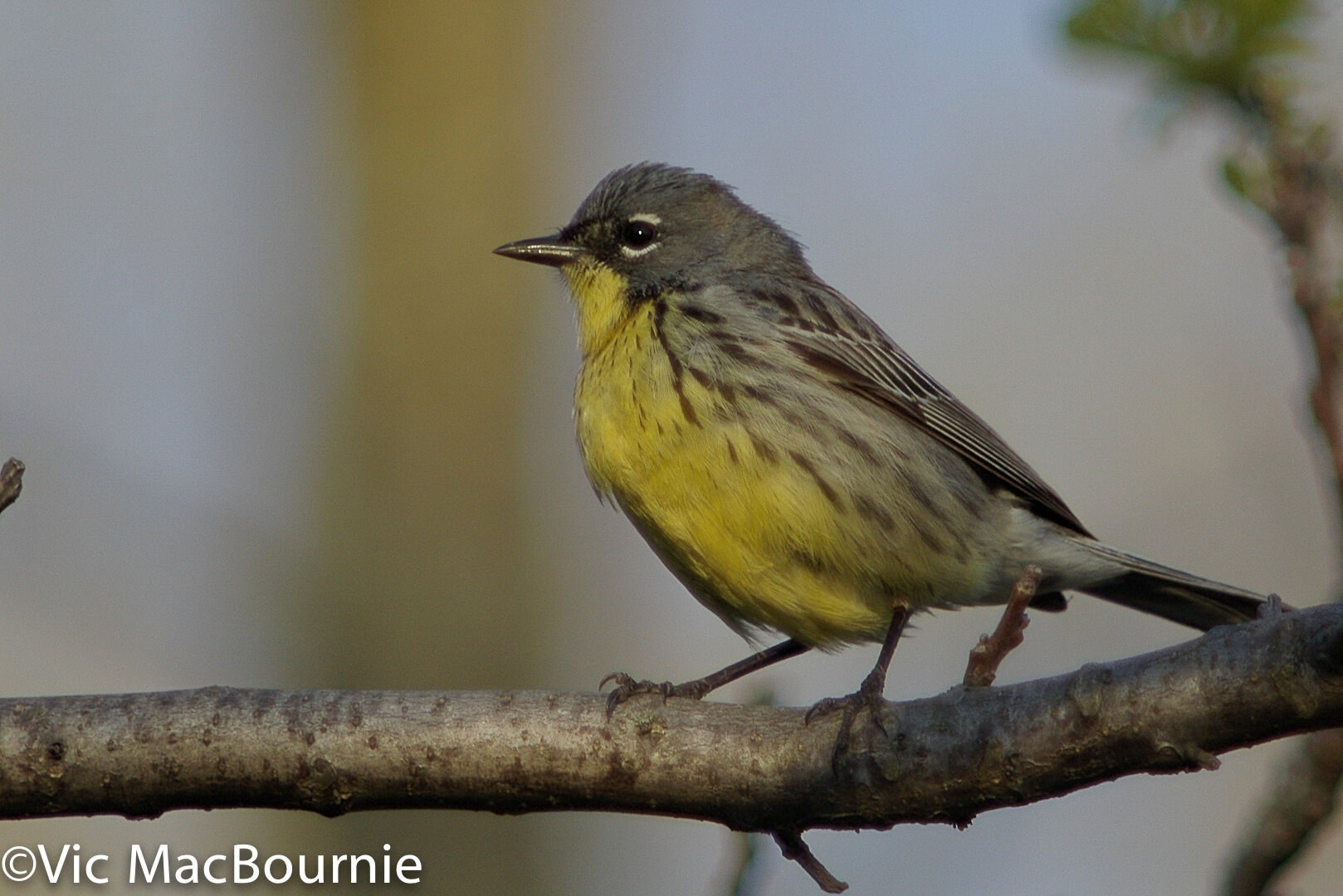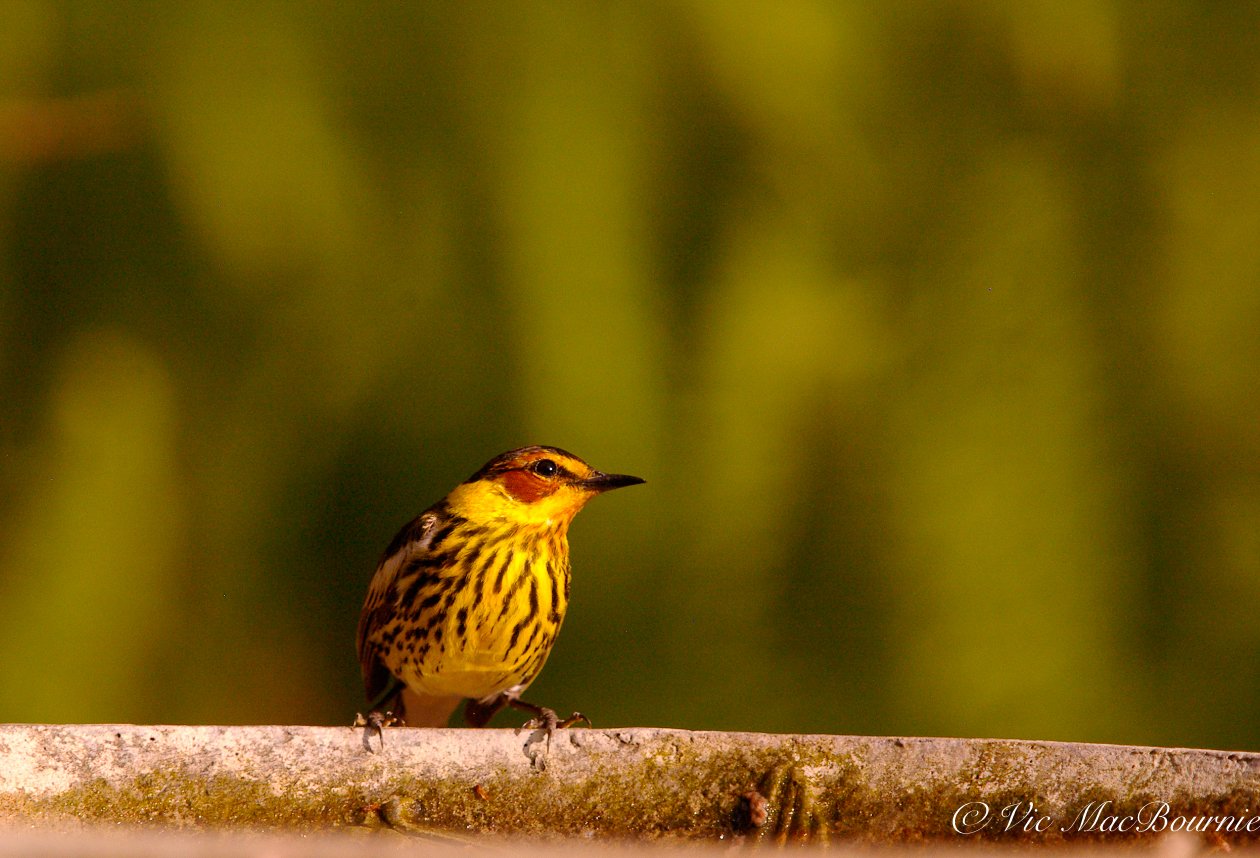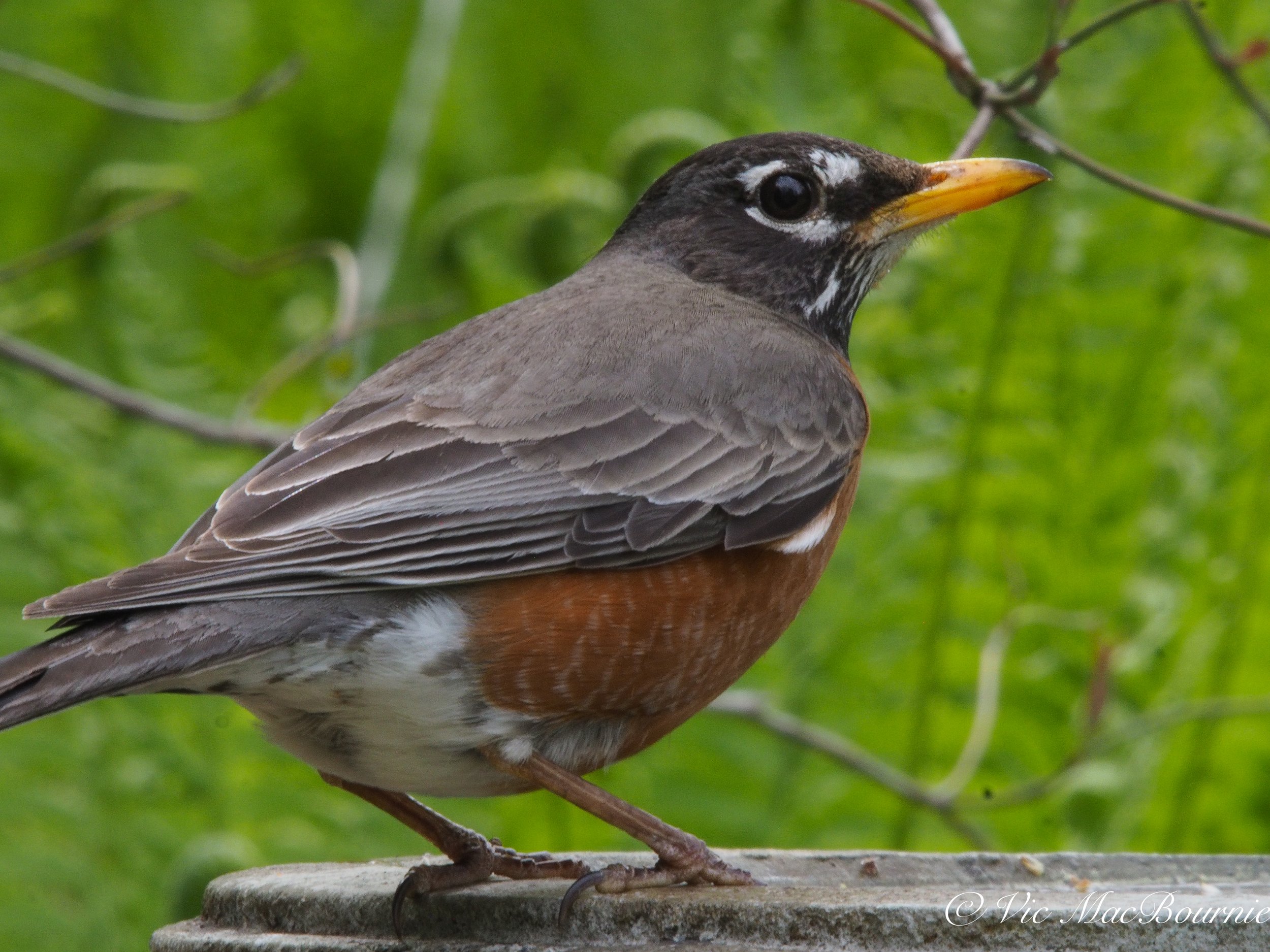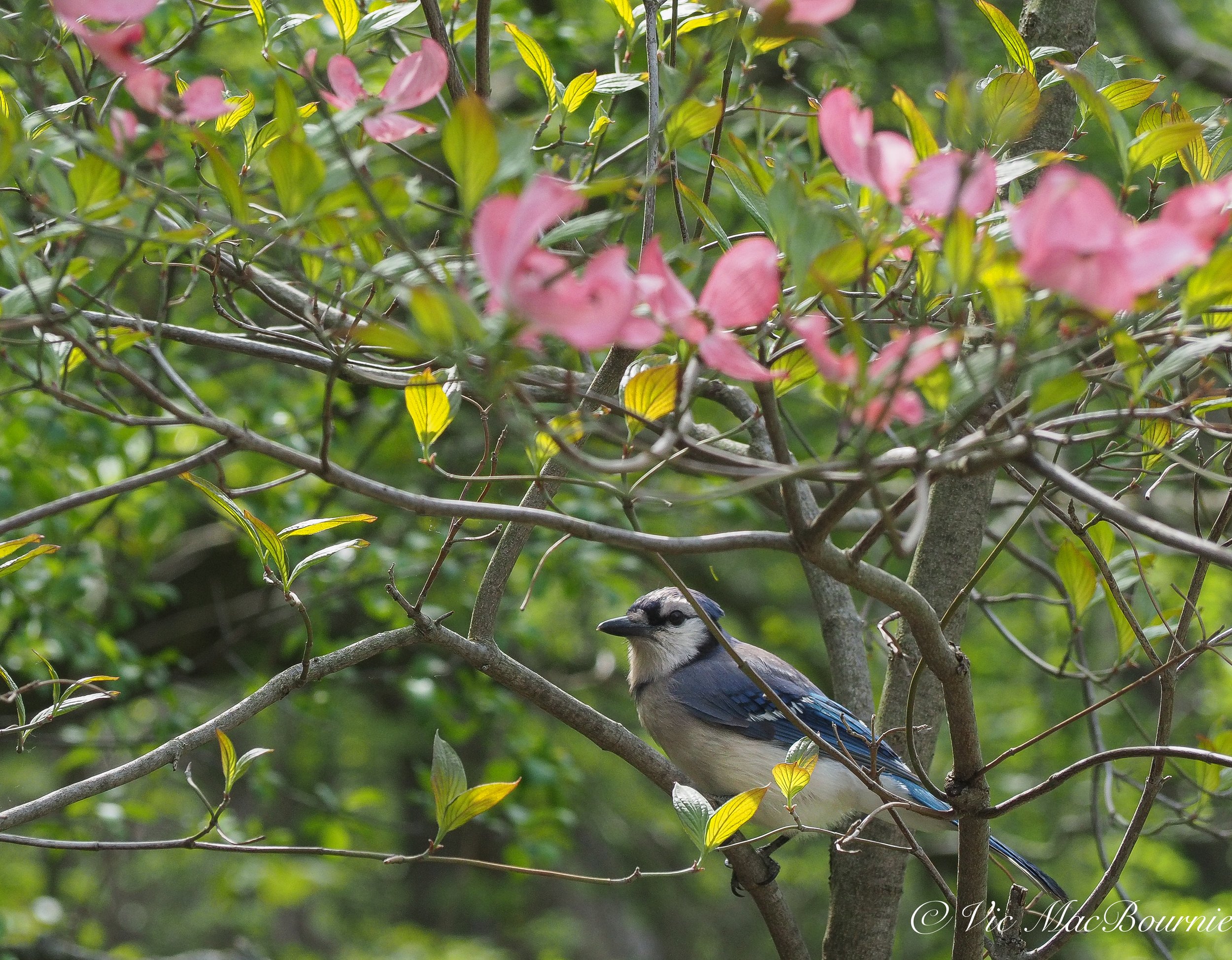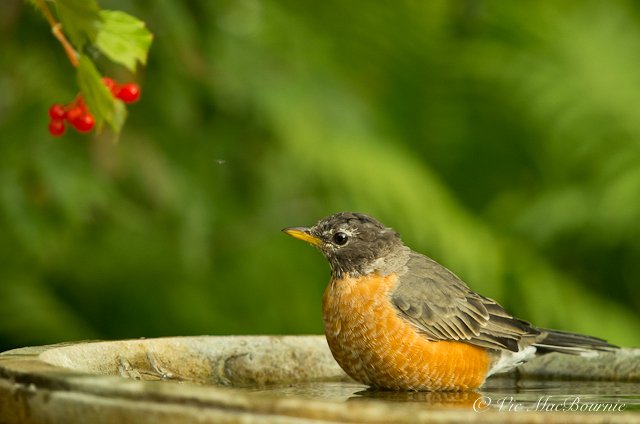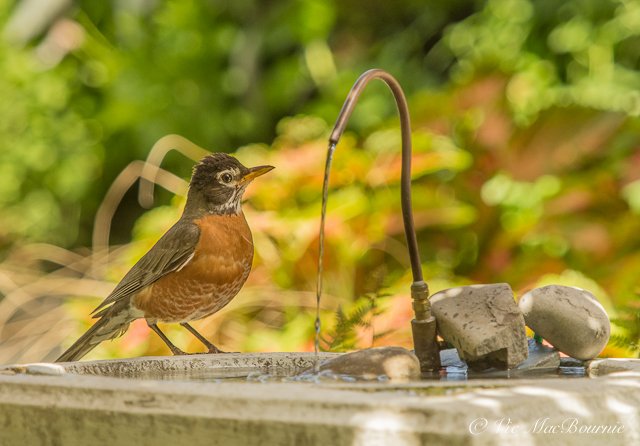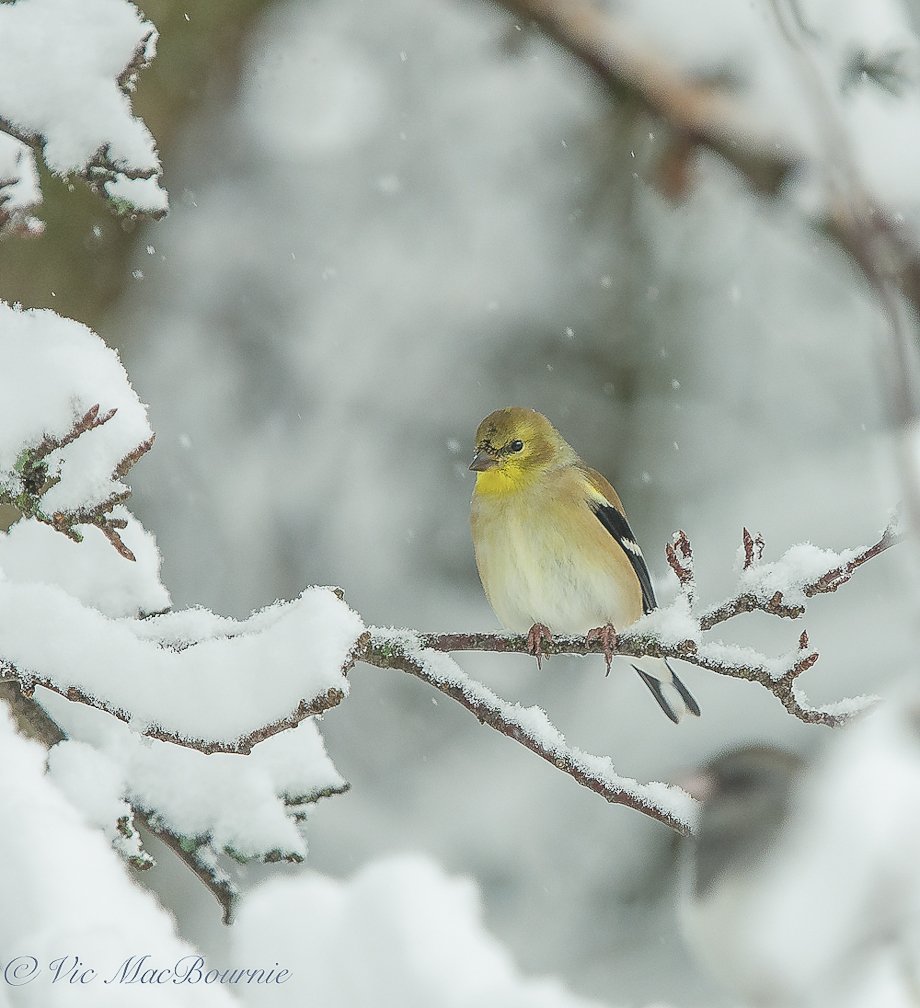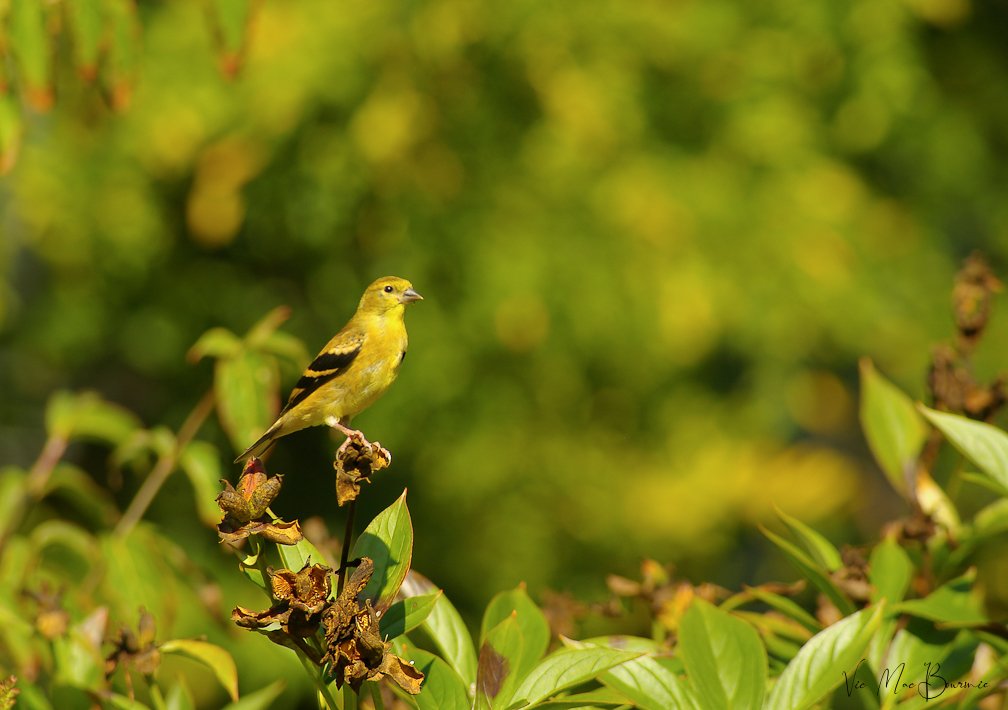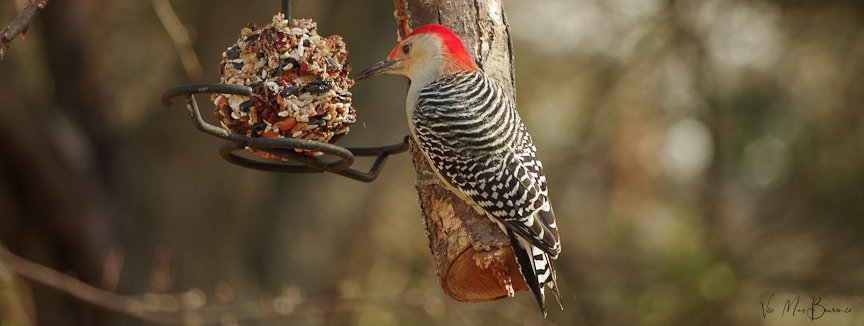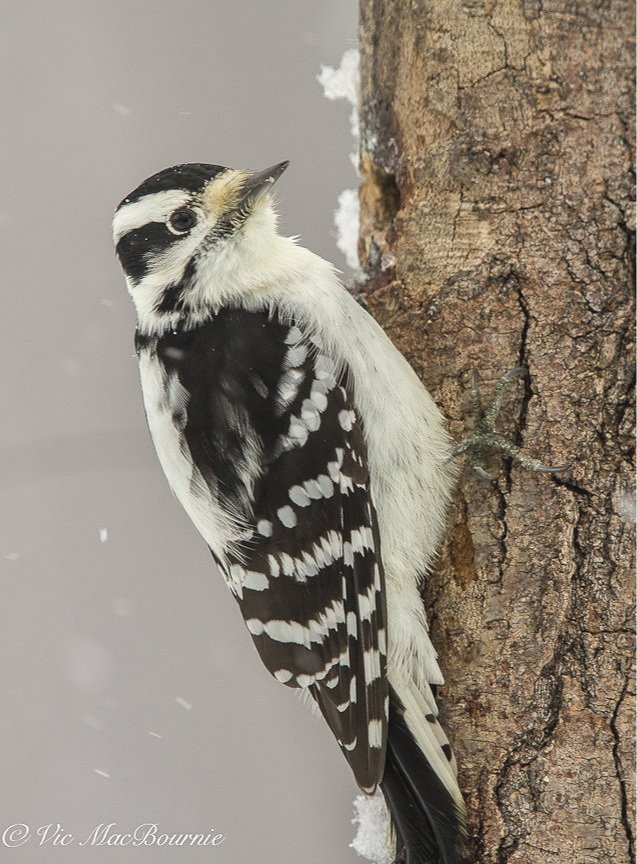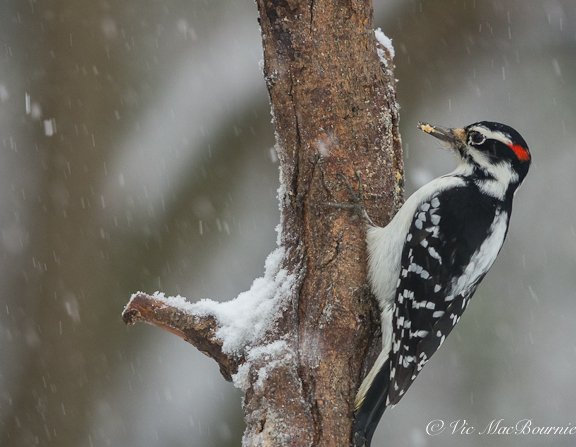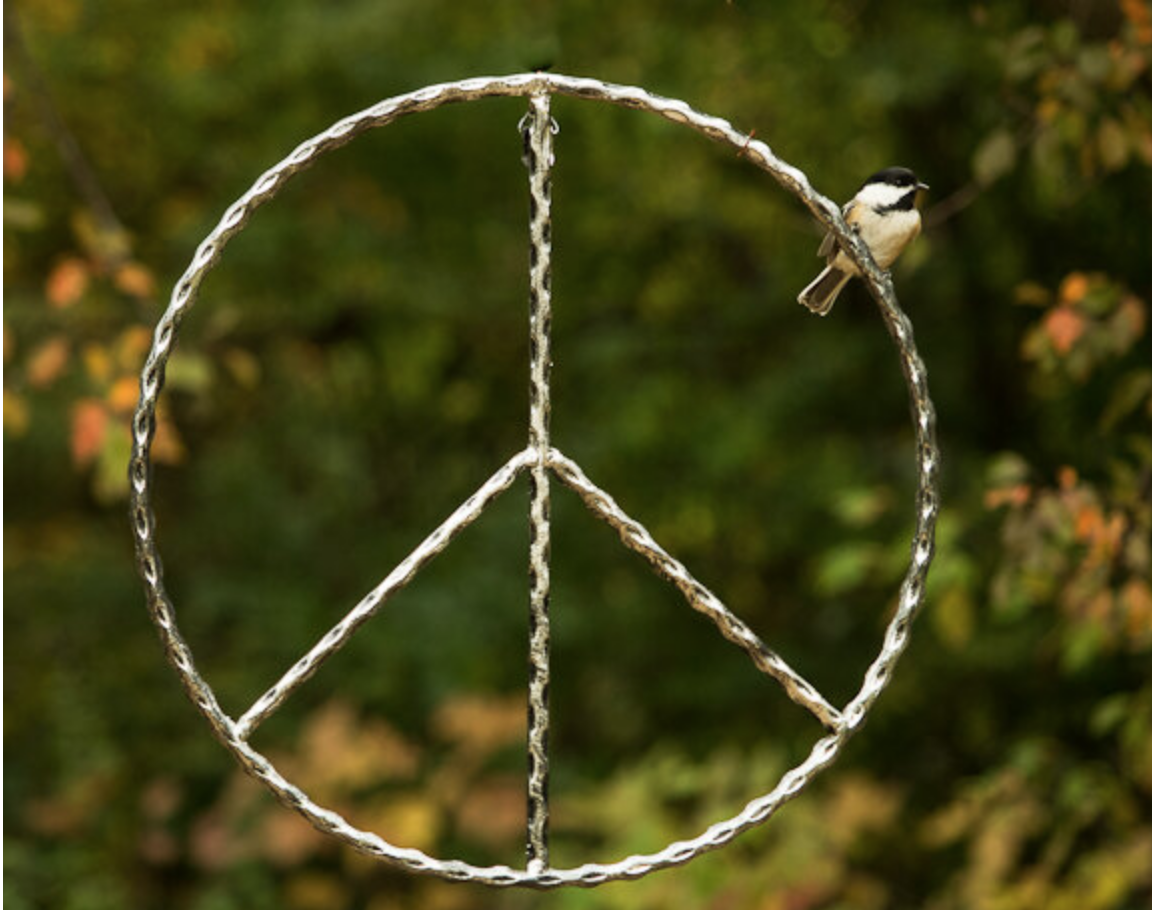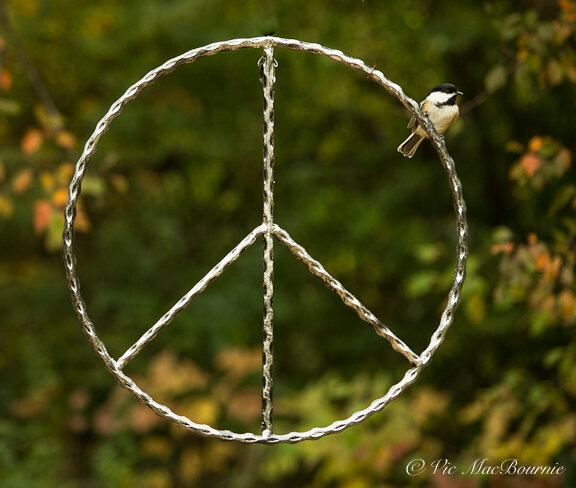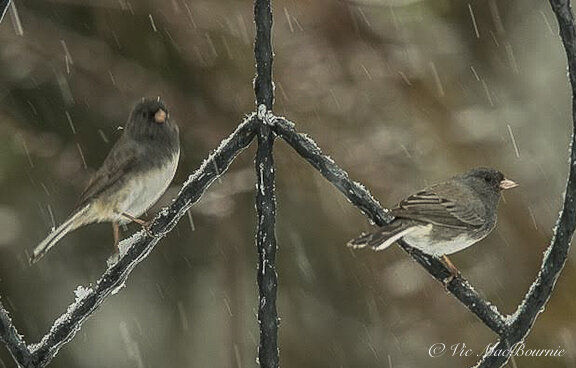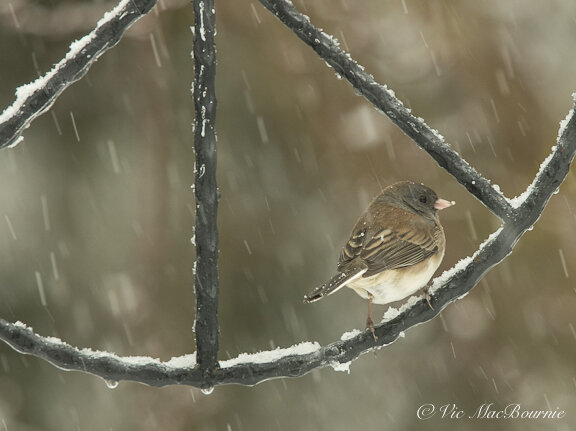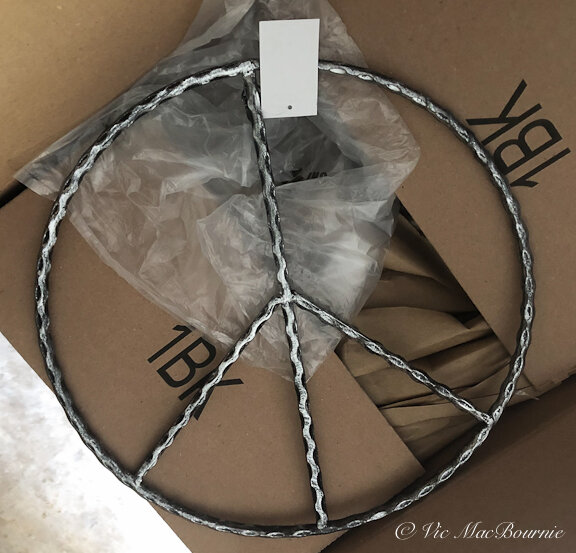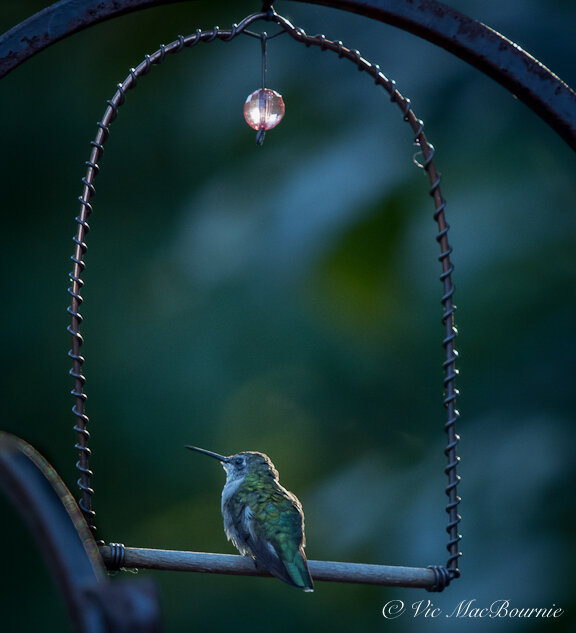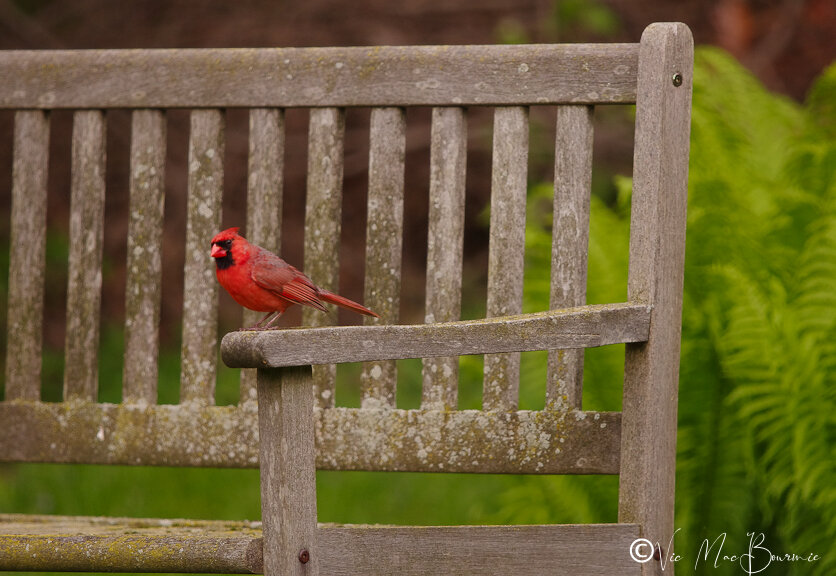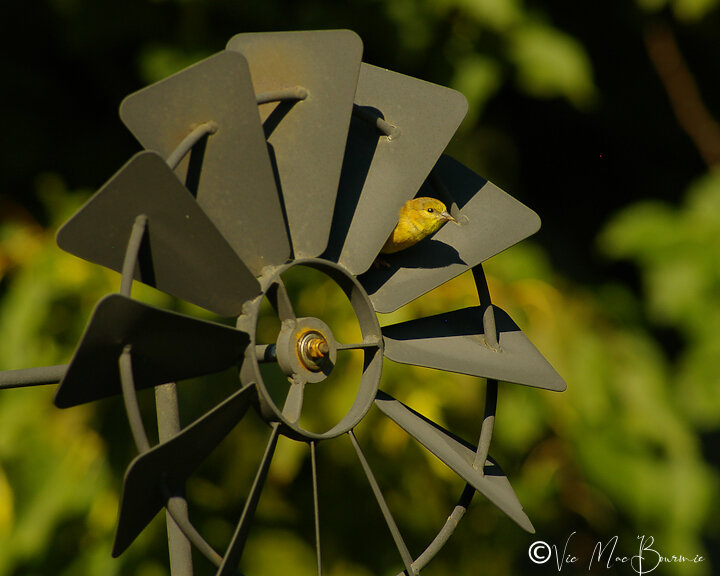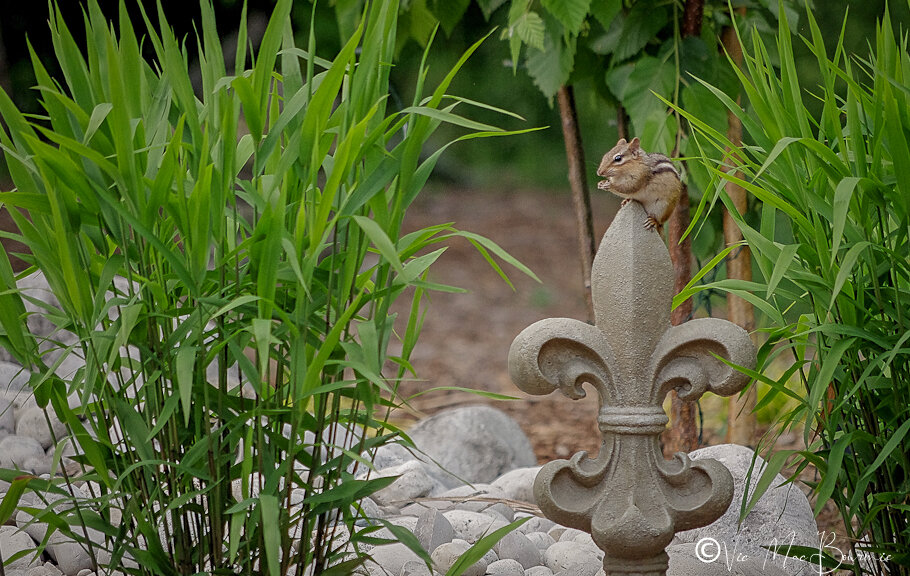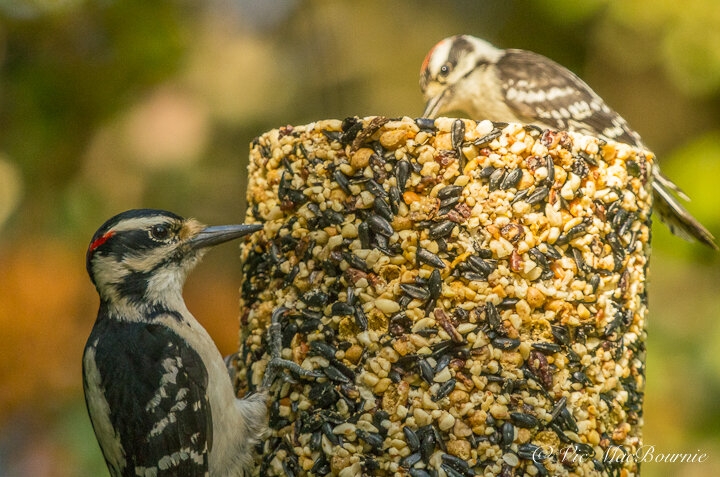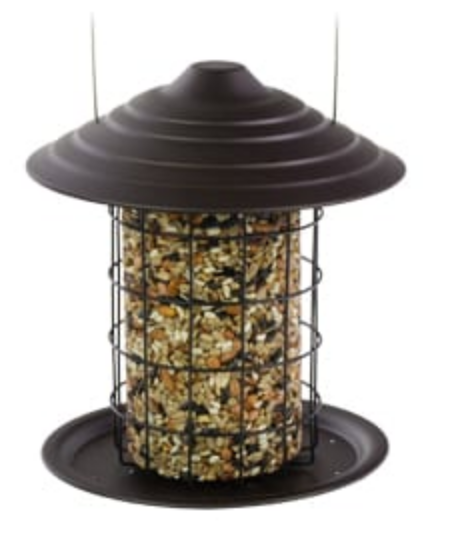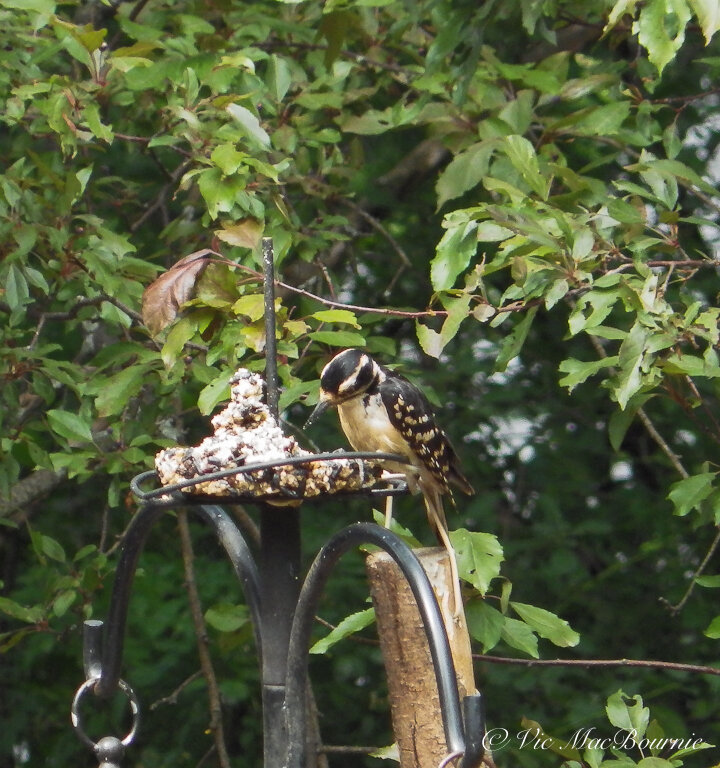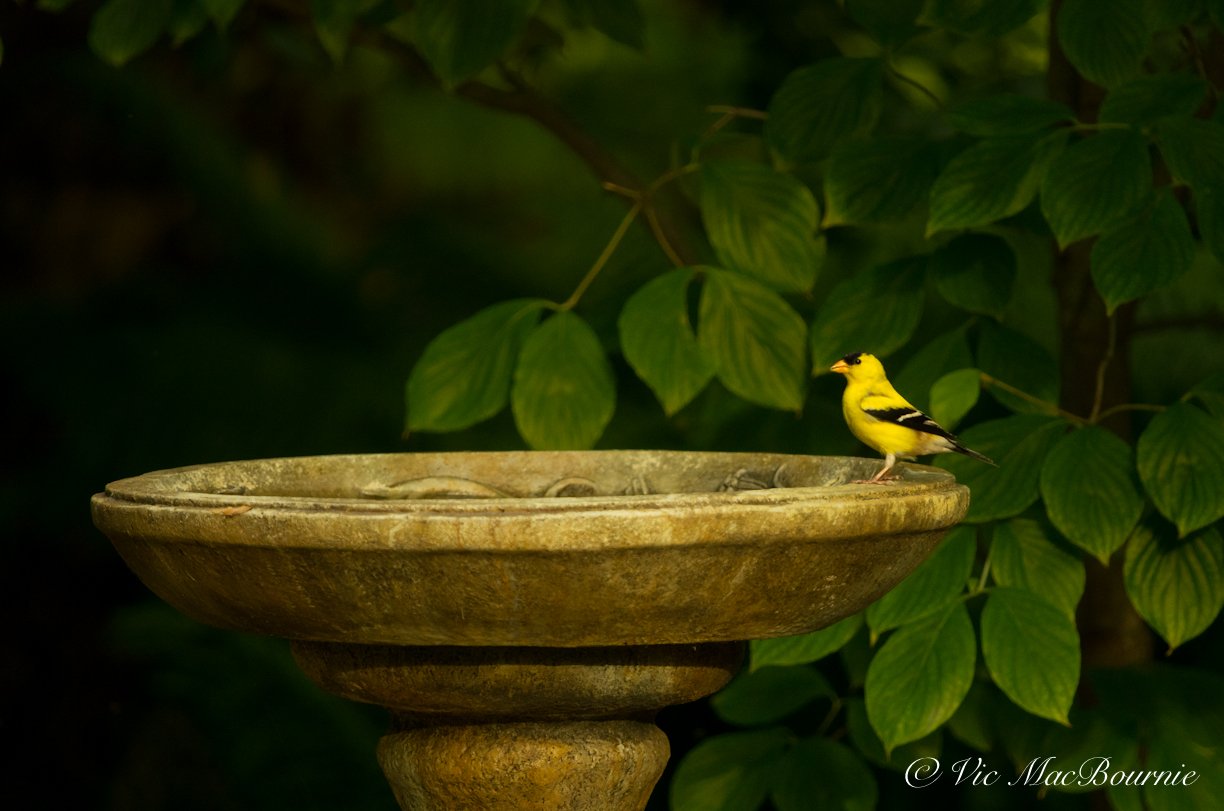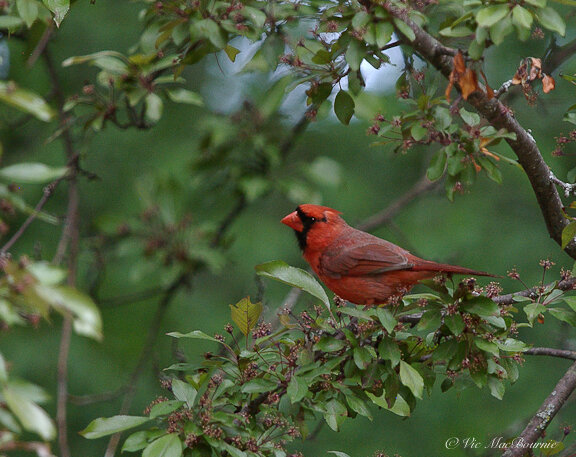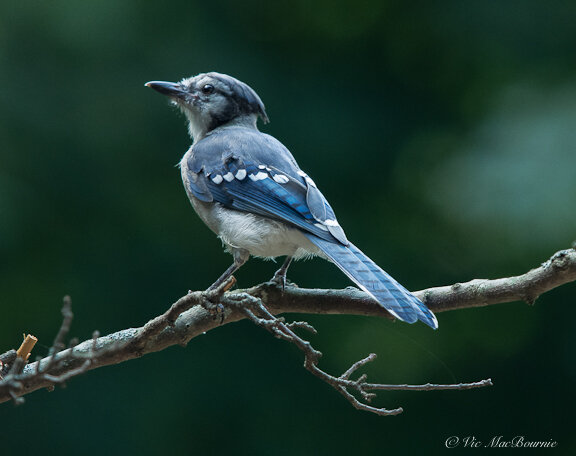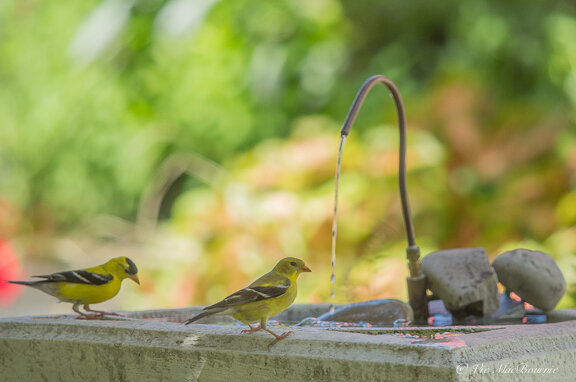A weekend of warblers in the woodland garden
It was an unforgettable weekend of warblers in the woodland garden. Here’s how it happened and how it can happen to you if you create the right habitat.
How to attract warblers, even for a weekend
It was an unforgettable Mother’s Day weekend of warblers in our woodland garden.
It started with a quick glimpse of what appeared to be a Blackburnian warbler flitting about in the blooms of our yellow magnolia tree capturing insects, and ended with me sitting in my Tragopan photo blind photographing warblers from a few feet away as they came down for a drink in one of our many bird baths. The bird bath that seemed to attract them most happened to be directly under a flowering dogwood in full bloom.
Some non-birders (my wife included) might say “so what, they’re just birds.”
To that I say: “No, warblers aren’t just any birds. They’re special, and these species don’t normally hang out in gardens. At least not where I live in Southern Ontario.”
We had Blackburnians, Cape May and Yellow-Rumped warblers… and that’s just the ones I saw.
In fact, most birders know full well that the annual pilgrimage to Pt. Pelee’s Festival of Birds, on Canada’s southern most tip, is really one of the only ways to catch a glimpse and hopefully a photograph one or two of some of these more rare warblers that are all filtered to the tiny spit of sandy forest on Lake Erie. Most of the birds are so exhausted from flying over the lake that they take refuge at the Point of land and, in many situations, allow a close approach.
Birders come from around the world just to catch a glimpse of some of these rare warblers and other migratory birds.
So, to have a few drop down into our little woodland during their migration to more northern locations, is an honour I don’t take lightly.
In fact, for a brief second or two, I had two Cape May warblers (see image below) drinking from the bird bath at one time.
How many warbler species worldwide, in North America?
Warblers are one of the most common types of birds, and, hence, they have a wide distribution, covering Africa, Europe, North and South America, Australia, Asia, the Pacific islands, and the subarctic region.
I read recently that Old World (Europe) warblers are in the family called Sylviidae and comprise close to 350 species. In Europe they are related to the thrushes and the flycatchers.
Although warblers look similar and are often mistaken for finches, wrens, or sparrows, they are not related songbirds.
Here, in what is considered the New World (North America), there are 52 species of warbler. In North America, Warblers are members of the wood-warbler family (Parulidae). Worldwide, there are 13 families called warblers.
That’s a lot of warblers worldwide.
But, I would bet that most people (outside of birders) have either never seen a warbler, or would not be able to identify one even if they did.
Warblers are a group of small birds that are also known as perching birds. Their plumage can range from drab colours like gray and brown to bright colours like vibrant red, blue, and yellow.
They might be best know for their trilling and quavering songs, which is actually how they earned their name. Their songs range from rather dull to loud and piercing mating calls in spring.
The name warbler actually comes from an Old French word “werbler,” which means to sing in trills.
How far do warblers migrate?
Identifying their calls might be the easiest way to know they are in the garden.
Their beautiful, almost tropical-sounding songs, are a reminder of how far they’ve migrated to get to our gardens. Many are travelling from Central and south America to far reaches of northern Canada to breed.
Are warblers common in the garden?
One of the reasons more gardeners are not familiar with these birds is because they are not common backyard birds.
The warblers that do visit backyards are elusive and most often spend their time higher up in the tree canopy where they have access to more insects, caterpillars etc.
So, even the more common warblers like the Yellow warbler, often go unnoticed by most casual gardeners who may mistake the flash of yellow for a Goldfinch or even a female oriole.
The Cornell lab or Ornithology is an excellent place to go for help identifying these birds or to get more information.
Can you attract warblers with typical birdfeeders?
Your typical birdfeeder full of sunflower, millet and other goodies is not going to bring warblers into the yard.
You need insects, caterpillars and other creepy crawlies to attract these primarily insect-eating little beauties.
And, for so many gardeners, that’s the problem.
Two Cape May warblers enjoying one of our bird baths. To capture a single Cape May warbler is thrilling enough, but to get two in one frame was a real thrill.
One only needs to go on any of the garden forums on Facebook to read about the insect carnage.
In fact, I am finding it extremely difficult these days to follow garden groups on Facebook when every second question is about how to kill insects and caterpillars in the garden.
Let me scream it from the tree tops: “It’s natural to have insects, caterpillars and other creepy crawlies in your garden. Let Mother Nature take care of them the way she has for thousands of years. This IS birdfood.”
Okay, sorry for the rant.
And, I’m not saying there are not situations where action needs to be taken to deal with a major infestation, but it should be rare rather than a daily occurrence in the garden.
How can we attract warblers?
But, back to weekend warblers in the woodland garden.
I am convinced – or at least I’m going to try to convince myself – that one of the reasons the warblers chose our garden to spend a few days is the availability of insect life, and reliable sources of water in several areas of the garden.
Without these, the warblers would have had no reason to drop down preferring to continue on their way to better locations.
Black and White warblers are less colourful than most but are beautiful in their own simplicity.
To make the weekend of warblers even more special for me, is the fact that we are surrounded by acres of wild forest that I’m sure would have been an excellent source of food for these warblers.
But, by intensifying the availability of insects through a variety of native plants, shrubs and trees, our gardens can become magnets for migrating birds in need of quick hits of energy via insects and caterpillars. Also, I witnessed a number of the warblers rooting around in the fallen leaves for insects.
Some, like Indigo Buntings and Orioles, (links to my posts) might stick around and call our garden home for the summer. If so, they, along with more common backyard birds who depend on an abundance of insects and caterpillars in spring to feed their offspring, will help to keep any outbreak in check while they bring life, colour and their sweet songs to our gardens.
So, if you hope to attract warblers to your garden, even for just a short period during migration, you need to ensure the following:
Reliable sources of fresh water preferably in a variety of birdbaths and natural looking ponds including patio container ponds and on-ground baths. A natural pond with easy access to shallow areas is excellent for all wildlife.
Native plants, shrubs and trees that in turn attract plenty of insects, spiders, caterpillars and other creepy crawlies. Oaks, willows and birch trees are good starters but our warblers seemed to be drawn to our flowering yellow magnolia and dogwoods, which no doubt were attracting insects to the garden.
Leave your fallen leaves. I noticed that the warblers were often on the ground rooting through the fallen leaves from the previous fall, which never really get “cleaned up” in our gardens. Most of the leaves stay where they fall and are just moved off walkways onto the gardens where the spring flowers force their way up through them.
Do not use any insecticides in the garden. Learn to live with the odd outbreak and let Mother Nature do her job to keep the garden in a natural, balanced state.
Interesting facts about warblers
• Warbler migration begins in April from South and Central America making their way down to Canada and the United States. Some, such as the Tennessee warbler and Magnolia warbler, fly farther north to breed in Canada’s boreal forest as well as a few small areas in the United States.
• The more common yellow warbler and yellow throat are seen throughout parts of Canada and the United States.
A beautiful but more common Yellow warbler searches the grasses for insects. Yellow warblers are more common in woodland gardens, especially those that have extensive forests or woodlots nearby and are hosts to native plants, shrubs and trees that attract insects and caterpillars.
• Warblers tend to have thin bills, which enable them to pick up and hold on to insects and caterpillars.
• Because of their colour and active lifestyle, they are often referred to as the butterflies of the bird world.
• Warblers are fast-flyers and can reach impressive speeds of up to 25 mph or (more than 40 kilometers per hour.)
• They can fly long distances: For example the Canada warbler travels more than 3,000 miles during migration
• Warblers songs: Warbler songs are used not only to attract mates, they’re also used to communicate with one another. Warbler mates have even been known to sing duets together.
A more rare Northern Parula warbler photographed at Pt. Pelee National Park. These birds breed in eastern North America from southern Canada to Florida.
• Suet feeders likely play a role in helping these birds survive the worst winters. So, it is a good idea to keep suet out all winter for the birds and to keep an eye out for special visitors. Who knows, you might be lucky enough to be one of the few who can say they saw a warbler in the cold of winter.
• Warblers depend on the boreal forest. In fact, more than half of the warblers breed in the boreal forest which stretches from Alaska into Newfoundland.
• What do warblers eat most? Warblers mainly eat insects, spiders, caterpillars and mosquito larvae.
• Although most warblers are solitary birds, they can be seen at different times of the year in solitary pairs, small groups and in small families.
• Why are they called warblers? Warblers picked up their names from the trills of their songs.
• What is the biggest threat to warblers: Warblers obviously face many threats during migration from hitting high-rise buildings to being caught up in dangerous storms and not being able to find enough food to survive migration. Other threats include parasitism and, of course, the actions of humans through the use of herbicides and pesticides. Climate change also poses risks to these small birds either from sudden extreme weather conditions to changes that affect the availability of sufficient insects at crucial times of the year.
• Warblers build a variety of nests mostly in trees, but also can be found in tall grasses. These nests can range from typical small cup-like structures typical of most nests, to domes in grasses, in bushes, or even hidden inside the ground. Typical construction material ranges from whatever might be available to them including hair (human or animal), long grasses, spider webs, and soft mosses and lichens.
• Warblers generally have an incubation time of about 12 days. The females have an average clutch of 2. The baby birds fledge after about ten days and are independent of their parents after as little as 2-3 weeks.
In conclusion
Normally we don’t attract warblers to our gardens. Instead, they decide to grace us with their presence in our gardens. We can, however, create habitat that is inviting to warblers and hope that they recognize our efforts, even if it’s just for a weekend.
That same habitat will be an invitation, not only to warblers, but to a host of birds, butterflies, mammals and reptiles.
A healthy garden will be attractive to a greater variety of wildlife than we can even imagine. The results are dependent so much on the location and the environment where the garden exists. All we can do is our best to create a welcoming habitat and hope for the best.
Photographing backyard Warblers, Robins and Blue Jays
For those interested in garden and wildlife photography, I thought I would give you a little background. While photographing warblers, I was also able to capture a robin and blue jay so I have included some of those images as well to illustrate the lens and camera capabilities.
My intro to bird photography
I’ll never forget my first introduction to serious bird photography.
It was at Pt. Pelee National Park during the Migratory Bird Festival when birders and bird photographers from around the world gather in great numbers to see and capture images of these tiny birds.
Let’s just say there were days when the photographers and birders outnumbered the birds 20:1. But it was certainly an eye-opening experience.
The bird photographers gear made the photojournalists at sporting events look like they were carrying point-and-shoot cameras and lenses compared to the monster lenses at the national park.
I can safely conclude that, judging from the size and quality of the lenses, many of the beautiful images you see of warblers come at a very hefty price tag.
Serious bird photography can be extremely expensive. Big, fast lenses can cost as much as a small used car. Not to mention the latest cameras, tripods and tripod heads. Add in the cost of overnight stays and travel to birding hot spots and you can imagine how the costs add up.
So, that makes stepping out into your backyard and catching a few shots of warblers almost priceless.
I was lucky enough to capture our weekend warblers with two very old cameras and a couple of vintage lenses: including a 20-year-old, 6 megapixel, Pentax istD and an 8-year-old Olympus OM-D E-M10 (link to my post) together with my favourite wildlife lens the 36-year-old Pentax 300mm F* f4.5 (link to my post) and the kit Olympus 40-150mm zoom lens.
Blue jay photographed with the Olympus EM10 and 40-150mm lens.
The crop factor on the 300mm with the Pentax istD gives me the approximate equivalent of a 420mm lens. I also used a converter on the Olympus that allowed me to attach the 300mm lens to the Olympus with a crop factor of two creating the equivalent of a 600mm lens.
The converter does not transmit any information to the camera and turns the lens from autofocus to manual focus. The Olympus, like many micro4/3 cameras have features that make using manual focus lenses much easier to use.
All this being said, capturing images of these tiny birds would not have been easy without my secret weapon.
The secret weapon for me is the Tragopan photographic blind that allowed me to get in very close to the birds. Once I recognized that the birds were regularly frequenting one of our bird baths, it was a simple matter to set up the blind near the birdbath and wait them out.
My goal was to capture an image of a warbler in the flowering dogwood. Unfortunately, I was unable to capture that shot, but I did manage to get them on the bird bath. During the process, I was able to capture a blue jay in the dogwood tree and on the birdbath. (see above).
American Robins: How to attract them to our yards
The American robin has always been a mainstay in our backyard whether they are eating crabapples or enjoying themselves in the bird bath.
More of these spring harbingers are remaining all winter
Most of us remember the first sign of spring involved an orange breasted bird and a worm.
Once we saw our first Robin pulling a worm out of the grass it was officially spring. Today, many of those same orange breasted birds are sticking around all winter living off berries, bugs, larvae and anything else they can scrounge to get them through our winters.
Milder winters resulting from climate change are certainly playing a role in more American Robins remaining in their northerly limits, but the threat of sudden and prolonged periods of freezing temperatures combined with heavy snow fall can certainly put the birds in severe danger.
It’s another good reason to ensure we do our best to supplement our bird feeders with more natural food for the birds – berries, fruit and even meal worms – especially during the winter.
Be sure to check out my comprehensive post on the best plants to feed birds naturally and save money.
Robins are regulars in our backyard
Throughout most of the winter, I watch a small flock of American Robins feeding off of our two crabapple trees in the back of the yard. I suspect it is an important food source for the resident Robins, when other food supplies in the area are scarce.
The American Robin is probably one of the most familiar birds in North America. In fact, it is actually the state bird of three northeastern states – Connecticut, Michigan and Wisconsin.
Where did the American Robin gets its name?
The American Robin got its name from European settlers who named it after the more diminutive and cheerful European Robin, which sports an equally impressive red breast and is often referred to as “Robin Redbreast.”
Although it is easy to see that the colouring of the two birds resulted in the identical names, the similarities more or less end there.
The American robin is actually a member of the thrush family and is much larger than its European namesake. Those who have studied the history, say that the two birds were given the same name as much for their character as their colourings. Both birds readily adapt to urban areas and are happy to live among humans, in fact, they eagerly stay close by to benefit from potential insects we sometimes stir up in the garden.
Whether you are in England digging a new garden bed or New York, chances are a robin is nearby watching your every move. And, don’t be surprised if they come right down to your feet to nab an unearthed worm or other insect.
It turns out the European settlers didn’t stop giving North American birds the Robin moniker after bestowing it upon the American Robin. Apparently, even our beloved bluebirds were tagged with the name robin. That’s understandable since the Eastern bluebird sports a lovely orange breast and reflects many of the traits of the European robin when it comes to size and characteristics.
But that didn’t end the Europeans obsession with naming our birds after their beloved robins. Towhees originally earned the name ground robin and Baltimore Orioles were called the Golden Robin.
Obviously all four sport red-orange breasts that undoubtedly played a role in being compared to the friendly European robin, a mainstay in any British garden.
In fact, the American robin in all but colouring, is more related and shares more things in common to the Eurasian blackbird. Other than its colouring –which is all black – the blackbird is also in the thrush family and sports similarly to the American robin, a yellow beak and white around its eye.
Early Americans also called the bird the wandering thrush, which seems a more accurate description.
Robins love a good bath
If there is one thing in our garden that the robins love most, it’s our many bird baths sprinkled about. if you are looking to attract Robins to your yard, a couple of good, solid, large bird baths are essential. You will be amply rewarded, if you can keep a good reliable source of water for them throughout the winter.
Be sure to check out my article on creating a DIY heated bird bath for the winter.
American Robin is actually a woodland bird
Although the birds are a common sight in residential yards and parks, this wasn’t always the case. American Robins are actually woodland or forest dwelling birds that have learned to adapt to the abundance of food – primarily worms in grass – in surburban landscapes.
Many of our American Robins end up returning to woodlands and more “wild” areas in the winter,where they can more easily find food – in an abundance of berries and other fruit as well as overwintering insects and larvae.
Creating a more natural yard, by planting plenty of native berries as well as leaving leaf litter for overwintering insects and larvae, will help to attract these wonderful birds throughout the winter.
Creating this natural food source in your woodland/wildlife garden will also go a long way to ensure the survival of the American Robin in your neighbourhood.
Robins love their bird baths. Be sure to ad a birdbath or small pond to attract these members of the Thrush family.
How do Robins survive winter?
During the winter, it is common to see the Robins travelling in large flocks where they work together to find natural food sources. Winter roosts can be huge with some estimates reaching more than two hundred thousand birds.
But, just because you see flocks of Robins in your area one year, does not mean they will necessarily return the following year.
Robins tend to be nomadic birds that don’t follow the typical north to south migration route. Individual Robins get around and may winter in completely different geographic areas from one winter to another. They have been known to travel long distances between states following the abundance of food in any given year.
Each spring, however, Robins return to their original nesting area and have even been known to use the previous year’s nest – with some modern improvements of course – if it proved successful the previous year.
A few facts about Robins
• In more northern regions of Ontario for example, Robins continue to be known as the harbingers of spring. They tend to show up around the end of March through early April as the warmer weather thaws the ground making worms and other insects more accessible.
• Worms only make up 15-20 per cent of the Robin’s summer diet. The rest is made up of other insects, fruits and berries.
•Robins tend to eat more earth worms in the early morning when they are more visible and closer to the surface, and turn to fruit later in the day.
• Robins belong to the Thrush family – family of birds known for their beautiful songs. Because Robins tend to hang out in neighbourhoods and around other human-dominated habitats, their spring songs are very familiar to most of us wheter we know it or not. Their rich, cheerful songs fill our neighbourhood each spring when they are particularly vocal announcing the arrival of spring and their readiness to mate and get on with building their families. Robins are known to sing their songs throughout the day and even will after sunset.
• Because Robins are comfortable in our gardens and around humans, it is not uncommon to have a pair nesting close to our homes and high-traffic areas such as on top of exterior lights, in hanging baskets on garden ornaments or just about anywhere the pair can find a good sturdy structure to build their nest. Last year, our neighbours had a pair nesting in a wreath near their front door, seemingly oblivious to all the comings and goings.
The birds’ ease around us often provides excellent opportunities to observe the family as they grow up in front of our eyes.
They can be the perfect opportunity for children to be exposed to the beauty of nature as they watch the parents on the nest, feeding the young and eventually watch as the fledglings leave the nest.
If you have children or grandchildren who express an interest in nature, be sure to check out my comprehensive post about why children need more nature in their lives.
Robins can nest up to three times in a breeding season, often using the same nest. However only about 40 per cent of the nests produce young and only about 25 per cent of those young Robins survive through fall to take on the winter. About half of the Robins that go into winter survive to mate the following spring.
Given those statistics, it’s not surprising that American Robins have an average lifespan of about 1.5 to two years, but they can live longer if given the right environment. For example, the longest lived American Robin recorded in the wild was almost 14 years old.
How to identify the American Robin
The American Robin is one of the easiest birds to identify with their rusty red belly against a greyish-black upper body, a bright yellow beak and white markings around their eyes.
These rather large birds measure around 25 centimeters long and weigh in at 77 grams, making them the largest thrush in North America.
The can be found right across North America from the farthest reaches of Alaska in the north, across to Canada’s Newfoundland and down south from Florida across to California.
Are American Robins threatened?
Robins face a hose of deadly foes around our residential gardens from the over use of insecticides especially on turf grass where they feed on worms and other insects, to the presence of unnatural predators such as cats, and collisions with windows.
Be sure to check out my two earlier posts on protecting birds from stray cats and how to protect birds from window strikes.
A more serious threat that has recently attacked American Robins is the mosquito-born virus West Nile that has killed a stunning number of both Robins and Blue Jays.
Be sure to check out this link for my comprehensive post on Blue Jays and West Nile.
Despite these challenges, the good news is that studies are showing that the American robin populations over the past 40 years have slowly increased. This increase is thought to be related to their ability to adapt their lifestyle to live comfortably in our suburban neighbourhoods.
The combination of a more readily accessible food source (worms), safe nesting places (unnatural as many of them are) and milder winters have no doubt combined to provide American robins with a fabourable environment despite the many threats they face in the suburban landscape.
How do our bright yellow Goldfinches get their colour
The stunning colour changes of the American Goldfinch is unmatched by most backyard birds. These changes can be traced, in part, to its almost entirely vegetarian diet of seeds, most notably the seeds of thistle, sunflower and milkweed.
A digital watercolour image of an American Goldfinch sitting out a winter storm.
Bright yellow bird’s colour change and the common thistle
The story of the American Goldfinch’s bright yellow colour and why it changes from a drab greyish brown in winter to a stunning bright yellow in early spring really begins with, and is tied to, its diet of almost entirely seeds – primarily seeds from its favourite food, the thistle plant.
If you want these colourful “wild canaries” in your woodland garden, let the thistles grow in a corner of your yard or, if you want to watch these beautiful little finches attack your thistles, plant them near your favourite sitting area or a window. Be sure to include sunflowers and milkweed as well for some spectacular late summer entertainment.
What you will notice is that later in summer these thistles and other native plants will begin to flower and put out seed just in time for the Goldfinches to take advantage of this abundance of seed to feed their, most likely, one and only brood of nestlings.
Okay, so what does this have to do with the male Goldfinch taking on its bright yellow spring colour and the female’s subtle soft yellow coat?
It is thought that the timing of the moult and the transformation into its beautiful yellow plumage in spring is related, at least in part, to natural seed production. The Goldfinch’s late winter/spring moult is unusual because most birds can’t use up that much energy in spring when they are trying to raise their nestlings, but because Goldfinches depend almost entirely on the consumption of seed, they are able to nest later in the season following a spring moult.
American Goldfinches are unusual among goldfinches in moulting their body feathers twice a year, once in late winter and again in late summer. The late summer moult takes place after the nestlings are born and are more independent of their parents.
Of course, the male’s bright colour relates to the mating season, but unlike most birds that begin nesting in early spring timed in part to the explosion of insect and larvae life that feeds their nestlings, Goldfinches breed later and feed its nestlings almost entirely seeds.
Check this link for more on the American Goldfinch and attracting colourful birds to your yard
An American Goldfinch quietly waiting for its turn at the Nyjer bird feeder during an early winter snowstorm that helps explain the bird’s still-vibrant plumage colours.
When do Goldfinches begin nest building?
Goldfinches don’t begin their mating ritual and nest building until later in the summer – June and July in the eastern part of their range and as early as May and June in their western ranges. By this later date, the transformation from drab, easily overlooked birds to the stunning yellow plumage of the males and more subtle yellow of the females is usually completed. In fact, by late April the moult is usually complete and the birds can begin building back any energy lost as a result of the moult.
The birds’ almost entire dependency on small seeds also mean they don’t need to rely on insects. This is particularly helpful during winter months when insects are in short supply and helps explain the fact that few of the birds migrate far distances if at all.
Moving water proves too much of an attraction for these male and female American Goldfinches. The male can be seen with its black cap waiting for its turn in the bird bath.
Cool facts about the Goldfinch
The Cornell Lab of Ornithology, in their informative website, provided some of the following facts:
Goldfinches incorporate the fibrous seeds of thistle and milkweed, which they also use to feed their young, into their nests.
Goldfinches begin moulting in September, and continue for six to eight weeks During this time they molt all of their feathers, ending up with a completely new set of drab-coloured feathers heading into winter.
In the spring, as new body feathers are grown, the males especially transform into bright yellow breeding plumage, but the wing and tail feathers remain from the previous fall.
American Goldfinches are among the strictest vegetarians in the bird world, only inadvertently swallowing an occasional insect.
American Goldfinch nestlings usually leave the nest two weeks after hatching but continue to be fed by the parents for a period of time.
Although American Goldfinches traditionally only have one brood, an experienced couple may have a second brood. In this case the female builds the new nest while the male continues to feed the first brood.
Brown-headed Cowbirds that lay eggs in an American Goldfinch nest can’t survive on the all-seed diet and perish quickly.
The oldest known American Goldfinch was 10 years 9 months old when it was recaptured and rereleased during a banding operation in Maryland.
A Golfinch looks for seed in the Woodland Wildlife garden where it feeds almost entirely on the seed of native plants and trees.
Where do Goldfinches get this bright yellow colour
This cheerful bright yellow plumage of the male Goldfinch and to a lesser degree the females comes from carotenoids in the plants and plant seeds that they ingest.
The Cornell Lab of Ornithology explains in their article on How Birds Make Colourful Feathers that: “Carotenoids are responsible for the bright yellows seen in goldfinches and Yellow Warblers as well as the brilliant orangish yellow of the male Blackburnian Warbler. Carotenoids can interact with melanins to produce colours like the olive-green of the female Scarlet Tanager.”
Some bird species, whose feathers remain the same colour year round, such as the Cardinal, Blue Jay or Chickadee, the annual moult serves to simply refresh their plumage. Others, like the Goldfinch, use the moult as an opportunity to change their colours from vibrant breeding ones to those that help to camouflage them from predators. The bright yellow plumage of the Goldfinch would do little to hide them in the stark winter landscape. For American goldfinch, that means going through a second moult in the spring, to regain their bright breeding colours.
What other natural seeds do Goldfinches eat?
Thistles are not the only seeds eaten by these small birds. Their strong beaks allow them to open an assortment of seeds including another one of their favourites – sunflower seeds. They also eat seeds from asters, wild grasses and several trees including alder, birch, western red cedar and elm.
Most of us are familiar with the popular (but expensive to purchase) Nyjer seed which is used almost exclusively in special feeders to attract these birds. Although most people think Nyjer seed is the seed of the thistle plant, it is actually the similarly small, thin, black seed from the African yellow daisy (Guizotia abyssinica). Though unrelated to the thistle plant, it is high in oil and a popular source of food for the Goldfinch.
What to do if Goldfinches are not eating your Nyjer seed
Nyjer seed should always be purchased from a reputable seller preferably one that has a high seed turnover because older seed quickly dries out and loses its nutritional benefits. If you notice that finches stop eating from your feeder despite the fact it is full of Nyjer seed you may have just recently put out for them, it is likely that the oil in the seed has dried out and it is no longer useful. At that point it is best to dispose of it and purchase new, fresh seed.
In addition, Nyjer seed is easily spoiled when it gets wet. Even condensation building up at the bottom of the tube feeder can cause the seed to go rancid. Replace and clean the feeders on a regular basis to keep the Goldfinches coming back regularly.
If American Goldfinches are coming regularly to your feeder, September and October is a good time to pay particular attention to them. It is at this time of year that they transition from their stunning golden colour to gray.
Once the transformation is complete the Goldfinches can still be identified by their wings which are mostly black with a thick, buffy bar and white edging during flight.
In conclusion
As Woodland Wildlife gardeners we are often told about the importance of using native plants in our gardens to not only help protect these often threatened species, but to provide birds, pollinators and other predators with a critical food source – either pollen and nectar or the protein provided by insects and caterpillars who live off of them.
The American Goldfinch provides the perfect example of how these native plants provide an important source of food in the form of seeds. In fact, the entire life cycle, mating, giving birth, even moulting is dependent in some way on the production of seeds from a specific group of plants and trees.
For the ill informed, these critical plants, namely thistle and milkweed, are not often desirable plants to have in our gardens and are shunned by many traditional “tidy up” gardeners.
Maybe these gardeners would prefer to pay for an endless supply of Nyjer seed to feed the few Goldfinches that are passing through rather than let the birds natural food source grow in a corner of their yard.
Never has it been more important to embrace native plants and because of the dwindling supply of natural seeds you may be doubly rewarded for your efforts to grow these critically important native plants.
Three common woodpeckers and how to tell them apart
Woodpeckers are common visitors to our feeders in winter and summer. telling them apart can be a problem considering they share some of the same characteristics – especially the Downy and Hairy Woodpeckers. The Red-Bellied Woodpecker can be confusing to some because it’s not easy to see the subtle red on its belly.
Downy, Hairy and Red-Bellied Woodpeckers: What they eat
Woodpeckers are probably the most common bird at our feeders most winter days.
Between the Downy, Hairy and Red-Bellied there always seems to be at least a couple working the seed cylinder that sits atop our feeder pole, or one of the many suet feeders that provide them with a high-fat source of food when the weather turns colder. It’s also common to see them flitting about searching out the Bark Butter and DIY feeders I leave on home-made snags that have been set up around the feeders. They will also readily take the black-oil sunflower seed in the feeders.
Although they are among the most frequent visitors to our feeders, their primary food source is without a doubt insects and larvae of all kinds. In fact, even in winter when insects are sparse, these woodpeckers keep busy using their long beaks to probe under or between bark in search of insects.
For more on feeding backyard birds check out these articles on The Tufted Titmouse, Seed cyclinders, Attracting Orioles, attracting Indigo Buntings.
The vibrant red head of the Red-Bellied Woodpecker complete with its zebra-like plummage across its back helps to give it a very distinguished look.
How woodpeckers catch insects
All woodpeckers share a number of special anatomical features that allow them to dig or violently carve holes in wood. Their chisel-shaped bills are constructed of strong bone overlaid with a hard covering that broadens toward the birds’ heads helping to spread the force of the birds’ heavy pecking. Woodpeckers even have a covering of feathers over their nostrils to help filter out wood splinters and dust that is generated during their aggressive pounding on trees.
Woodpeckers also boast long, barbed tongues that includes a sticky substance that enables them to search crevices and cracks for insects and larvae.
How to identify woodpeckers at the feeder
It’s easy to mistake one woodpecker from another considering all three are primarily black and white birds with similarly longish beaks. Their size and a few specific identification markings will help you identify these three birds at your feeder. Distinguishing between the Downy (actually the smallest woodpecker in North America) and the Hairy is difficult at times but with a little practise the differences become more obvious.
The Red-Bellied Woodpecker with just a hint of the red belly showing here.
Identifying the Red-Bellied Woodpecker
It’s not too difficult to identify the Red-bellied Woodpecker from its Downy and Hairy counterparts, but don’t look for a bright red belly to easily identify this larger woodpecker.
These birds do sport a spot of red on their belly but the marking is so subtle that it is easily missed unless you have a clear view of the birds’ underside.
Probably the easiest way to identify the Red-Bellied Woodpecker is its sheer size, in comparison to many other woodpeckers. Look for a black and white clear zebra-like pattern that runs down their backs with the male displaying red on its forehead, crown, and nape while the female only has red on her nape with a grey forehead and crown.
Red-bellied vs Red Headed woodpecker
Although the Red-Bellied Woodpecker might be mistaken for the Hairy Woodpecker, at least when comparing the size of the birds, a better comparison is probably made with the more elusive Red-headed Woodpecker. Size wise they are similar, but unlike the Red-Bellied Woodpeckers’ zebra-like pattern on its back, the Red-Headed Woodpecker has a solid black back with large white wing patches (not unlike the larger Pileated Woodpecker). Of course, the entirely red heads of both male and female Red-Headed Woodpeckers are easy distinquishing marks compared to Red-bellied woodpeckers’ where the male sports a large partial red cap.
A Downy Woodpecker identified by its smaller beak and the spotted outward tail feathers.
Comparing the Downy and Hairy Woodpeckers
There is no doubt that in the world of woodpeckers, distinguishing between the Downy and Hairy woodpeckers is the most difficult. The two main differences between the two is size and their tail markings, with size being the easiest distinguishing factor of the two.
Both sport primarily black and white zebra-style feathers down their backs (not unlike the Red-bellied Woodpecker) with a white stripe down the back from the shoulders to their rump, white bellies and flanks, and black eye patches. So, at first glance, they look very much like the same birds.
Besides the size difference – the Downy is considerably smaller measuring in at about six inches compared to the much larger Robin-sized Hairy that stands about 50 per cent taller than the Downy – pay attention to the birds’ bills. The Downy’s bill is delicate and smaller – about a third the size of the Hairy’s much stronger, stout bill.
The larger Hairy Woodpecker sporting a larger beak and clear white outward tail feathers.
Finally, if all the above fails to convince you of what you are seeing, the Downy woodpecker’s outer tail feathers are barred with black, while the Hairy sports all-white outer tail feathers.
Most important, is how to remember the names of the two similar looking Woodpeckers. I use a word association that has never failed me – The Downy is the Diminutive one. In other words, the Downy is always the smaller and more Delicate of the two woodpeckers.
Where do these woodpeckers live?
Downy woodpecker at home in wooded areas
The diminutive Downy Woodpecker Picoides pubescens lives year-round across much of North America and is considered the most common woodpecker in eastern North America where it can be found nesting in holes in trees.
It is at home in a variety of wooded areas, including northern mixed forests and in the deciduous forests to the south. It’s equally at home in smaller urban woodlots and parklands, in orchards and in backyards with appropriate tree cover.
In its westerly range, the birds can be found in alder and willows.
The Hairy Woodpecker likes more mature forests
The larger Hairy Woodpeckers are more often found in more mature forests across North America. Although the Hairy and Downy woodpeckers share many of the same habitat, the Hairy woodpeckers need larger trees to live and successfully breed. It’s for this reasons that their numbers are thought to be declining in many areas where they are forced to compete with Starlings and House Sparrows.
Hairy woodpeckers will accept a wide variety of habitats from woodlands to river groves, they need large trees in deciduous, coniferous and mixed forest locations.
Although they can be found almost all over North America even up into Alaska and down through the southern states, some birds from the northern edge of their range may move well south in winter, while some who spend summers in the higher elevations of the Rocky Mountains will readily move to lower elevations.
The Red-Bellied woodpecker is expanding its range
The Red-Bellied Woodpecker is a positive story in a long list of negative ones when it comes to its numbers and habitat range. This large woodpecker, whose numbers are stable or even appear to be increasing slightly, has actually been extending its range to the north – possibly along with climate change.
Originally a bird that inhabited the southeastern parts of North America, this omnivorous woodpecker has adjusted to habitat requirements and now can be found in suburbs and urban parks as well as smaller woodlots and woodland gardens.
These cavity nesters make their homes in dead wood located usually less than 50 feet above ground. The male does most of the excavating for new tree cavities, but a nesting pair is not above using existing tree cavities whether they are natural or abandoned by other woodpeckers.
In conclusion
Identifying woodpeckers in your woodland garden can be daunting at first, but, eventually, you will begin to recognize their various characteristics including their often loud and rambunctious calls. They are quite friendly birds especially the Downy that will, with a little practise, readily eat out of your hand if tempted with high-quality black-oil sunflower seed.
Some homeowners may worry when they see a woodpecker banging away at one of their favourite backyard trees. I wouldn’t worry too much unless the woodpeckers are tearing apart the tree. But don’t blame them for the possible death of the tree. These important predators in our garden do much more good for our trees routing out problematic borers and other insects attacking the tree. If woodpeckers are tearing apart the tree, it’s likely because the tree is already fatally infested with borers.
How to attract the Tufted Titmouse
Attracting the Tufted Titmouse during the winter involves putting out a good supply of black-oil sunflower seeds. Keeping them around all summer requires a much more detailed approach involving ensuring a supply of insects, spiders and caterpillars, and good habitat that includes everything from fresh water to a supply of moss and, if possible, fur for them to use as nesting material.
Keep feeders loaded with Black Oil Sunflower and a supply of suet
It’s not hard to fall in love with the Tufted Titmouse and if you provide them with plenty of black oil sunflower seeds there’s a good chance they’ll be regular visitors to your winter bird feeders.
These sparrow-sized birds – close relatives to chickadees – love the small black oil sunflower seeds, but they’ll also readily eat, nuts and berries when they are available.
Black oil sunflower is the perfect food source for these little hoarders. You’ll notice that they take the seed, fly away from the feeder and often store it in the bark of a nearby tree for later consumption.
If the Titmouse is hungry, it will take the seed away to a nearby branch, hold the seed in its feet before opening its shell by pounding it with its strong, rounded little beak.
These gray birds are easily identified by the crested head feathers and soft orange flank feathers are also regulars at our suet feeders and, of course, are included in the long lineup of birds that can’t resist Wild Birds Unlimited’s Bark Butter, either the spreadable butter or the nuggets. (Check out my full report on bark butter here.)
Tufted Titmouse habitat: Encouraging them in your garden year round
All that said, Tufted Titmouse need more than black oil sunflower seeds to call your woodland garden home.
If you have, or live near, a heavily wooded area throughout the Eastern U.S., through Ontario and into Quebec, your chances are much better to have these birds in your garden year round. The birds were once thought of as a southern species, but have steadily expanded its range northward until today when it reaches southern Quebec and Ontario.
Tufted Titmice are primarily foragers of deciduous and mixed forests. They’ll fill your garden with their distinct peter-peter-peter song in spring during the spring breeding season.
(Be sure to check out my story on attracting Nuthatches to your feeder and my article on attracting colourful birds to your backyard.)
Although they rely on seeds during the winter months, their primary food source throughout the remaining seasons are insects, spiders and caterpillars.
They are also regular visitors to our many bird baths throughout the warmer months, particularly our regular cement bird bath located in a secluded area of the garden under one of our Flowering dogwood trees.
Ensure a good supply of insects in spring and summer
Providing this essential food source that the Tufted Titmouse depends on to feed its young requires a number of factors, including using more native plants in the garden to encourage insects that feed on those native plants, as well as removing pesticides from the environment. We can’t kill all the insects, spiders and caterpillars and expect to encourage birds to set up homes in our yards. Try to control insect infestations naturally, either by picking them off your plants or encouraging predators, such as birds, to control them for us.
For a detailed list of native flowers, shrubs and trees to attract birds, be sure to check out my article on Attracting Birds Naturally.
The Tufted Titmouse family is made up of a mating pair that stays together for a lifetime and raises three to five offspring at a time usually in a tree cavity, but often in a bird house, including blue bird houses.
Tufted Titmice are regulars to our bird baths and especially enjoy one that is secluded in the back of the garden beneath a Flowering Dogwood.
Tufted Titmouse use fur and moss in nests and bird houses
Their nests often include a combination of mosses, grasses and animal fur, but they will readily use a bird house in your garden as well. The tufted titmouse birdhouse share many of the same requirements as those of the nuthatches and chickadees.
The spunky little birds have been known to steal fur from sleeping foxes and dogs. They also have been known to pull hair from unsuspecting humans.
Most woodlands have at least some moss in the garden, but it’s never a bad idea to have a ready source available in the garden for the birds to use to line their nests.
Besides the Tufted Titmouse that we enjoy in our yards, more westerly residents enjoy the antics of the black-crested titmouse and bridled titmouse.
Along the Pacific Coast, woodland gardeners can enjoy the oak titmice, while Juniper titmice stay in the interior where they forage in the dry woodlands.
Garden photography: How to use props to photograph backyard birds
Capturing a little peace in the garden isn’t always about flower power. Try adding photographic props for birds to perch on to add a little whimsy to both your garden and your photographs. A peace sign is a “cool” prop that birds flock to like beatniks as free pot party.
Using garden props for backyard bird photography is a great way to add a little fun and whimsy to your garden photography and with the right props, the results might just “blow your mind.”
Cool peace sign prop for backyard bird photos
Flower power takes a back seat in this garden photography project.
All summer our focus has been on capturing the beauty of garden flowers, but that changes as fall approaches and we begin to focus more on birds and other areas of garden photography.
Fall is the perfect time to add a little fun to our photographic projects and using garden statuary, tools and even props can result in many memorable backyard bird images. While capturing a backyard bird in its natural environment is usually our ultimate goal, no one says we can’t have a little fun and create a backyard photo studio that includes using props much like a professional photographer would use to capture images of children, families and even our pets.
This wanna-be-hippie came up with an idea to combine a love of all things 1960s with a passion for birds, photography and gardening.
So what could be better than a metal peace sign – the “coolest” bird perch ever.
Even the birds are groovin’ it.
“If everyone demanded peace instead of another television set, then there would be peace.”
The peace sign is all part of my search for fun landing spots to photograph backyard birds. By placing props around the garden and near bird feeders, there is no end to the fun photographs available to us. Great bird photographs don’t have to reflect pure nature in our gardens.
If I could have only one lens for wildlife and birds in the garden, it would be my F* 300mm F4.5. Check out my full story on the lens by clicking the link.
Some of the best photographs I’ve seen celebrate the garden experience and welcome our forest friends to enjoy the garden – and its man-made ornaments – along with us.
By moving in close the peace sign is still recognizable but the focus changes to the bird rather than the prop. A soft backyground adds to te simplicity of the image.
So it’s really a small step from photographing them on our existing garden tools, ornaments and patio accoutrements, to setting up fun props to catch them in entertaining poses.
“No one is free, even the birds are chained to the sky.”
The “Peace sign” just seemed too perfect to pass up.
A quick search on Amazon brought up the coolest “Peace sign” – the perfect landing spot for backyard birds waiting for their turn at the bird feeder.
A couple days later and my Peace sign arrived all packed up and ready to become the latest perch for our backyard birds. After wrapping some copper wire around the perch to attach to the bird feeder pole, all that was left to do was to hang it and wait a few days so the birds can get acquainted to their cool new perch.
They took to it like beatniks would to free pot at a poetry reading party.
The peace sign perch is actually just one of many sprinkled throughout the garden.
This image was taken with a Fujifilm X10 equipped with a 28-112mm lens and shows what can be accomplished with a little planning. It helps to gain the trust of the wildlife in your garden. For more on the Fujifilm X10, go to my complete review here.
Setting up perches for an outdoor studio
It helps to keep the perches close to where you normally relax with your coffee and camera.
Eventually, one of our garden critters, whether it’s a backyard bird, chipmunk or friendly red squirrel, will explore the man-made garden perch. By keeping an eye on the spot, and watching how the light plays on the perch, it’s easy to capture it in the best light.
By hiding a handful of sunflower seeds on or near the perch, you can encourage the backyard models to the area much easier.
Most animals in our backyards like to get up high to keep an eye out for potential predators. I mounted this native bee and butterfly house on a pole and it didn’t take long for our local red squirrels to claim it as a lookout.
The simple grey background of the backyard shed helps the subject stand out and certainly does not hide the fact that the image was taken in a backyard. I was lucky enough to be in a photographic blind working the nearby feeder, when I noticed the squirrel watching me from the bee house. Although the Tragopan blind made getting the shot a little easier, these guys are friendly enough to photograph without a blind.
Focus on hummingbirds: Swinging in style
One of my favourite photography props is our elegant little hummingbird perch, a favourite spot for the local hummers to hang out.
I mount it just a few inches above a feeder where they like to perch and defend their food source.
Knowing that morning light creates a nice backlit situation made catching this rim light on the hummingbird as simple as setting up the tripod over several mornings until the bird landed in the perfect spot with just the right light.
If you are looking to upgrade your photography, consider checking out KEH Camera Exchange for excellent deals in used camera equipment from the latest camera bodies to a wide assortment of lenses.
This Cardinal gives our garden bench the perfect pop of colour. There’s no need to move in close in this case, better to show the bird in its environment.
The garden bench makes the perfect prop
A garden bench is another excellent perch for backyard birds. Waiting for the male cardinal to get into the perfect spot took some patience but the pop of colour on the aged wooden bench makes for a classic garden photograph.
I decided it was best to stay back and not move in too close in this instance. Photographers often try to move in too close to birds, when a more environmental portrait actually works better.
In the image below, a closer approach seemed appropriate to catch the Chipmunk in the lovely evening light on the edge of the bench. The close approach was, at least in part, thanks to working from within my Tragopan Photographic blind. (For more on using the blind for backyard photography, check out my full report here.)
Goldfinch on windmill.
Catching the critical moment
It pays to have your camera by your side at all times in the garden. This little goldfinch was having a terrific time on the garden windmill. I was lucky enough to capture the image just when it popped its head out to have a look around.
Seconds later it was off to explore another part of the garden.
Chipmunk takes a quick break on garden ornament.
We’re are blessed in our yard with an abundance of curious chipmunks who never fail to amuse. This little guy was caught eating his lunch while I enjoyed a glass of wine on the nearby patio.
Seed cylinders: One of the best feeders for backyard birds
Seed cylinders are an excellent way to feed backyard birds. The cylinders keep the birds at your feeder longer and can be changed depending on the season and the type of birds you are trying to attract.
Woodpeckers, nuthatches, cardinals love compressed seed cylinders
When it comes to feeding backyard birds, there really isn’t a better combination than a compressed seed cyclinder fitted to your feeding station.
I have had my “ simple spike” on my Wild Birds Unlimited Advanced Pole bird feeding station for several years and am so impressed with it that I consider it (and most of the birds agree) my primary feeding source for our backyard birds.
Why are seed cylinders so popular?
Seed cylinders not only bring in a large variety of birds, they keep them at the feeder longer so you can appreciate them more, and a single large cylinder can last for weeks compared to the equivalent amount of feed in a typical hopper-style feeder. They are also super convenient to use and are available in a variety of seed combinations meant to attract different birds at different times of year.
Seed cylinders are long-lasting, which makes them especially useful if filling feeders is difficult for you or you’re going on vacation and will be unable to fill your feeders for several days. The cylinders are especially great summer food for the woodpeckers during the heat of the summer when traditional suet feeding can be a challenge.
Blue Jays are also big fans of the compressed seed cylinders as well. Click on the link for more on two of my favourite Blue Jay feeders including the compressed seed cylinder.
The cylinders help to keep birds at the feeders longer because they have to work at the seeds to remove them from the cyclinders. At a traditional feeder, the birds often swooping in, grab a bite and take off, before you can even appreciate them. Seed cylinders can give you a few extra moments of enjoyment.
Our cylinder feeder attracts a host of birds including plenty of woodpeckers who enjoy hammering away at the cylinder to obtain their dinner.
Five Great reasons to use seed cylinders
Seed cylinders are convenient to use. They do away with bulky bags of seed and the waste that can occur when trying to load loose seed into feeders.
They keep birds at the feeder longer so that you can get a better look at the birds. They are especially useful to get good looks at more rare birds who visit such as Indigo buntings and woodpeckers.
Seed cylinders are available in several combinations aimed at different seasons and bird-feeding mixtures.
No-melt seed cylinders provide an excellent way to attract woodpeckers during warmer months when suet is not appropriate.
The feeders and seed cylinders are available in many sizes, including pucks where you can offer a variety of seed mixes at a single feeder.
The Advanced Pole system loaded with various feeders, including the seed cylinder at the top of the pole.
I purchased my cylinder spike probably ten years or more ago as a simple, inexpensive solution to replace an aging wooden open feeder.
I was looking to replace my homemade feeder with another similar open hopper-style feeder, but noticed the variety of seed cylinders available with the spike system. At the time there were far fewer choices than there are today, but still enough to convince me to move away from another hopper-style feeder.
Since then, Wild Birds Unlimited and other manufacturers have developed a number of newer feeders designed to work with their seed cylinders. (Here is a link to their assortment of cylinder feeders).
One of the drawbacks to my spike is that it does not provide any protection for the seed cyclinder from rain and snow.
As a result, the cyclinder can break down prematurely during periods of heavy rain and humidity. Although the birds may appreciate the ease at getting at the seed during these times, I prefer to make them work a little for their dinner.
Today’s cylinder designs solve the problem of an unprotected cylinder open to the elements. Most have a roofing system of some kind built into them to provide top-down protection to the seed cylinders and reduce the amount of premature break down.
I’m not sure our blue jays and woodpeckers would be happy if a roof covered their favourite feeder. They mostly just stand on the seed cylinder and pound away at it from the top.
The result, of course, is that the birds’ hard work further breaks down the top of the cylinder and opens it up to the elements.
Wild Birds Unlimited feeder complete with a cage to prevent large birds from dominating the feeder.
The new designs not only provide a roof for seed protection, several have cages to keep the larger birds from dominating the seed cylinders and giving our smaller birds a better opportunity to enjoy the benefits the seed cylinders offer.
There is no doubt that the larger backyard birds, including blue jays, woodpeckers, cardinals, grackles and even crows, descend on our cylinders and dominate them at times.
I’ll take advantage of any opportunity to restrict their access to the cylinders.
WBU’s globe cylinder feeder’s cage is large enough to accommodate mid-sized birds like indigo buntings, sparrows, nuthatches and downy woodpeckers just to name a few. The feeder handles the regular-sized cylinders which include the no-melt cyclinders. The cage also acts as perches for the birds.
And, if the pesky squirrels manage to get up to your feeder, the cage represents another barrier to protect your expensive seed.
WBU’s Tidy feeder combines the best of all worlds with a built-in roof, a cage and a base to catch any fallen seed.
The Tidy Cylinder feeder is a great choice providing not only a roof to protect the seed from the elements and a cage to protect the seed from larger, more aggressive birds, it also includes a small, built-in catch tray to keep the seed from falling to the ground.
Other modern feeders provide open access to the cylinders, but add several perching areas to provide more access for smaller birds to enjoy their meal in peace.
A mostly eaten seed cylinder shows how the spike attaches to the pole and how the seed cylinder fits over the simple spike.
How the spike system works
Setting up my cylinder spike on the Wild Bird Advanced Pole system was simple. One of the benefits of investing in a system allows you to easily add various options.
The spike feeder simply inserts into the top of the pole system. Once attached, the seed cylinder (which comes with a hole drilled through the middle of it) is inserted over the spike. My feeder has a circular perch at the base that surrounds the cylinder, but most of the visitors simply jump on the cylinder and begin helping themselves.
Many of the new cylinder feeders are meant to hang from hooks rather than be inserted directly in the pole. This provides more opportunities to use them on any pole system or hung directly in trees.
How are the seed cylinders made
Seed cylinders are a compressed mixture of seed, nuts, and/or fruit and, depending on the mix, insects such as meal worms can be added. The feed is compressed into cylinders and mixed with Gelatin to hold the seed mixtures together.
Then it is cut to size and ready for use.
If you are on a budget or just looking to save some money, making your own cylinders is easy enough. There are several step-by-step “DIY” projects available on both Google and YouTube that will guide you through the process.
While I get great enjoyment from my bird feeding stations, providing natural food sources to our feathered friends is always the goal we should aspire to in our gardens. I have written a comprehensive post on feeding birds naturally. You can read about it here.
How to attract colourful backyard birds (Cardinals, Bluejays, Goldfinches)
Who needs to go to the tropics to see colourful birds when you have them right in your backyard – Cardinals, Bluejays and Goldfinches. This article explains how to attract three of our favourite colourful backyard birds, how to feed them and how to keep them coming back to your yard.
What they eat and how to attract them
A Goldfinch stops by the birdbath to get a drink in the early evening.
When it comes to birds, everyone loves a little colour in their backyards. That’s why the Cardinal, Blue Jay and Goldfinch are among the most desirable birds in our woodland wildlife gardens.
The Cardinal, Blue Jay and Goldfinch are among the easiest, seed-eating backyard birds to attract to your feeders providing you are giving them their favourite foods. Add natural sources of food from berries to insects, nesting habitat, and, of course, a reliable water source and you will create plenty of colour in your backyard.
While I get great enjoyment from my bird feeding stations, providing natural food sources to our feathered friends is always the goal we should aspire to in our gardens. I have written a comprehensive post on feeding birds naturally. You can read about it here.
This image shows the subtle colour of a Goldfinch in winter during a snowstorm.
Of course these three stunners are not the only colourful birds we can attract to our backyards. My favourite colourful additions to the garden is the incredibly colourful Indigo bunting and the orange and black combination of the Baltimore Oriole. These two highly sought after and extremely colourful birds are more difficult to attract to your backyard feeders so I have tackled those in separate articles. (See my earlier stories on attracting Indigo Buntings and Orioles to your garden.)
To read my article on how the Goldfinch gets its stunning colour and how to attract them with native plants? Click here.
In this post, we’ll take a look at the Cardinal, Blue Jay and and Goldfinch: what they eat, where they nest and what little extras we can do to attract them to our backyards.
A male cardinal in a crabapple tree in spring.
Cardinals: everyone’s favourite backyard bird
It’s hard not to fall in love with Cardinals. Their cheerful persistent songs, the male cardinal’s bright red coat of feathers standing out in the landscape, and the buff-coloured female just as beautiful in her muted colours especially after a fresh snowfall.
These are year-round birds in our area and a regular at the feeders spring, summer, winter and fall.
A sure way to keep them around is to always have a supply of black-oil sunflower seeds in the feeders.
I use a no-mess blend of cracked sunflower seed from Wild Birds Unlimited.
Cardinals’ powerful jaws, and curved beaks give them the ability to easily open larger, harder seeds with great ease. They will readily take to not only both types of sunflower seed, but peanut pieces and safflower.
Cardinals are actually one of the few birds who seem tho really enjoy safflower seed. In fact, I have a separate feeder filled with safflower aimed primarily at attracting cardinals.
Cardinals will readily eat from most feeders, but consider providing them with a large platform feeder as well.
Although most of us know the cardinal as a regular visitor to our backyard feeders, seeds are not their only source of food. Like most birds, Cardinals rely on a steady supply of caterpillars and insects in early spring and summer during the mating season and to raise their young.
Host plants for butterfly larvae – including milkweed, coneflowers, goldenrod, black-eyed Susan aster, and lupines – will encourage cardinals into your yard and provide them with sources of protein to raise their young.
Cardinals are also attracted to fruit bearing plants, especially red fruit-bearing plants. The male cardinal actually gets its bright red coat from the carotenoid pigments in the red fruit. Serviceberry is a cardinal magnet in our garden but so too are are the berries of sumac and dogwoods. The red berries of the native Flowering dogwoods are favourites but not the raspberry-type fruit of the Cornus Kousa which is actually eaten by few if any birds.
(If you are considering planting a Serviceberry, be sure to check out my earlier article on this native tree and shrub here.)
The breeding season for the Northern male Cardinal runs from as early as March through to September. The nest, which is often found in dense shrubbery or in branches of smaller trees anywhere from 1-15 feet off the ground, is made up of twigs, bark strips bits of roots and even paper. It is often lined with vines, grass and hair.
Because they are not cavity dwelling birds, they are not attracted to a bird house.
They do, however, enjoy using backyard bird baths. Look for one that is two- to three-inches deep.
A blue jay shows off its stunning colours.
How about those Blue jays?
These guys might be considered bullies at the bird feeder but their incredible colour is just too good for most of us not to attract them to our backyard feeders.
And there isn’t a nut they cannot crack.
Start with a good helping of shelled or unshelled peanuts in a platform feeder and you’ll likely get your share of Blue jays in short order.
Their long, strong black bills are built for cracking open the hardest of nuts. In the forest, it comes in handy making short order of even tough nuts like acorns.
At our feeders, peanuts, large striped sunflower seeds, black oil sunflower seeds and the condensed seed cylinders (wild Birds Unlimited) favoured by Blue Jays and woodpeckers are guaranteed to attract them to your feeders.
Blue Jays are also attracted to corn, grains and suet at our feeders.
If you are looking to feed them naturally, acorns (from the oak tree) are an excellent source of food. Beechnuts (from beech trees) are also among their favourites.
While they are most often seen at our feeders, insects are still an important part of their diets including grasshoppers and caterpillars. The Cornell Lab of Ornithology reports that the stomach contents of Blue Jays studied over the course of a year showed that they contained about 22 per cent insects, with the remainder being acorns, nuts, fruits and grains.
We can’t overlook the fact that blue jays have been known to raid the nests of other birds and eat both the eggs and or the nestlings. If this is something that disturbs you, attracting Blue Jays may not be right for you.
Blue Jays nest from March through July in an open cup of twigs, grass, and sometimes mud, lined with rootlets. The nests are often in the crotch or thick outer branches of coniferous or deciduous trees. The Cornell Lab of Ornithology reports that Blue Jays often set up their nest in all types of forests but most often near oak trees on forest edges. They are quick to nest in both urban and suburban areas where both Oak trees and bird feeders are often in abundance.
Be sure to provide them with a reliable water source as well. A large, deep bird bath (3 inches at its deepest) will be a good source for your local Blue Jays.
Goldfinches at the bird bath with a solar-powered DIY dripper.
Goldfinches: Add a touch of tropical to your backyard
It’s not hard to think of the Goldfinch when Harry Belafonte sings about the Yellow Bird up high in banana tree.
One look at the male or female American Goldfinches in their finest colours is a reminder of how beautiful our local backyard birds are throughout most of the United States and Canada. No need to travel to tropical regions to see colourful birds and hear their lovely song.
More and more of our American Goldfinches remain here year round helped along by numerous bird feeders and seeds from our flower beds and roadside weeds.
These primarily seed-eating birds are drawn to Niger seeds at our feeders. Be sure to provide the small, black seeds in special feeders designed to allow access to the tiny beaks of the finches. Also available are finch socks filled with Niger that are easily hung from trees or a hook at the feeders.
In nature, Goldfinches eat mostly seeds, especially those in the daisy family. Although they do eat some small insects in summer as well as spring buds, bark from twigs, and maple sap, they always come back to seeds.
It’s not uncommon to see them foraging along fence lines in weedy areas gathering the seeds of thistle, grasses and the seeds from elm, birch and alder trees. Consider leaving an area in your garden to grow wild if you want to add a natural feeding source for Goldfinches as well as other birds that depend on these areas as a food and nesting area.
Audubon reports that Goldfinches are late season nesters, timing their nestlings just as daisy-like flowers begin producing seeds.
Nesting occurs mostly during late summer between July and August in deciduous shrubs or trees usually less than 30 feet above the ground. The nest is a compact cup of plant fibres, spiderwebs and plant down.
Goldfinches will readily come to bird baths. Consider a small, shallow one (depth 1-2 inches) for these diminutive colourful birds.
As an affiliate marketer with Amazon or other marketing companies, I earn money from qualifying purchases.





